If you haven’t heard the term ‘shooting brake’, you’re not alone. As a refresher, the definition of a shooting brake is usually a sleeker wagon, though before the 2000s hit, it was usually associated with cars with only two doors. Modern day shooting brakes are far more like wagons, though still with some coupe-like rooflines. Two shooting brakes that hit the market recently are the Volkswagen Arteon 206TSI Shooting Brake and the Genesis G70 Shooting Brake. We’ve tested both recently, so which is best? Let’s find out.
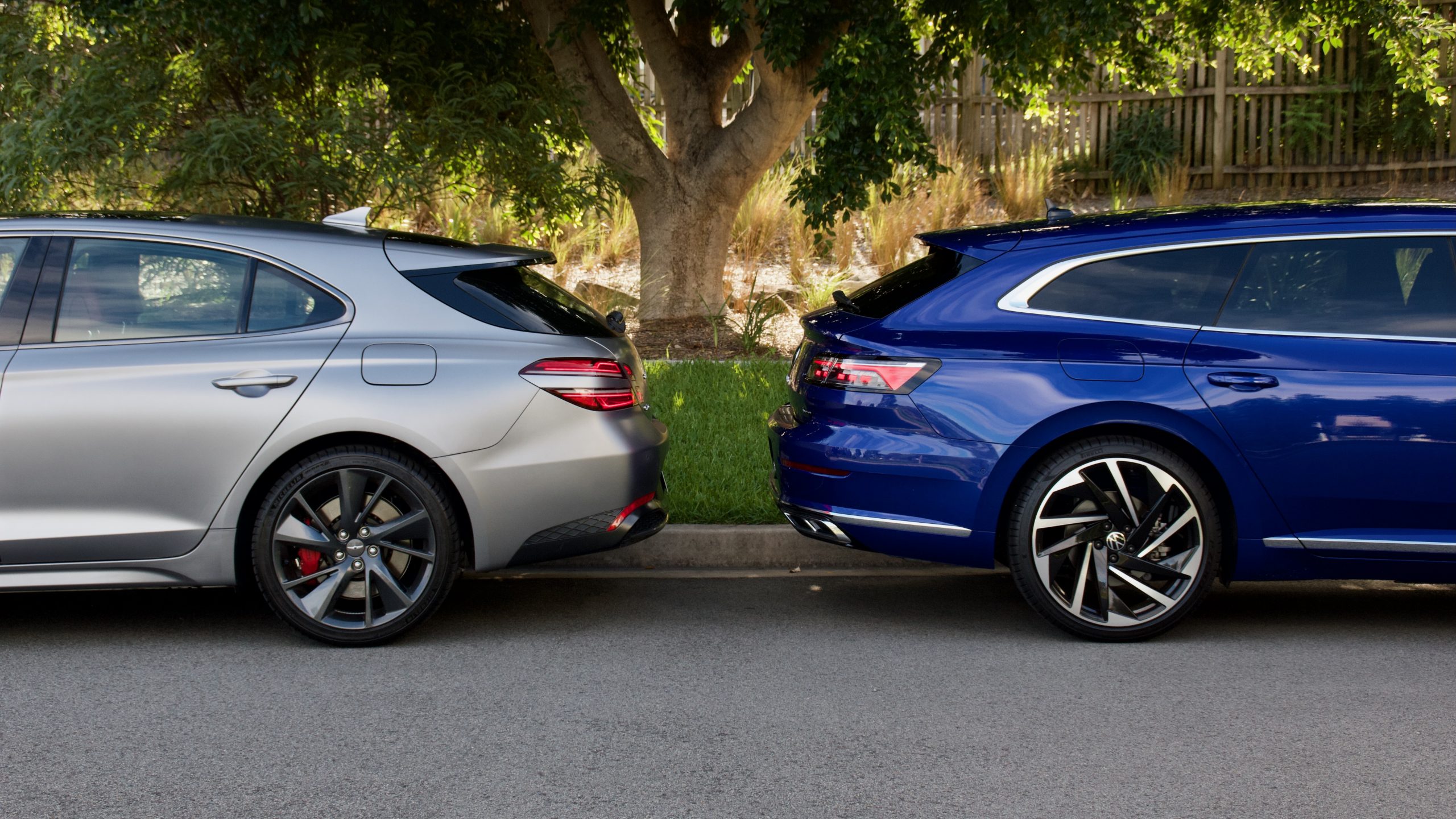
Thankfully – despite the SUV onslaught – there are still many wagon options available for under $80,000 in Australia from a variety of manufacturers. BMW has the 3 Series Touring, then there’s the Audi A4 Avant, Volkswagen Passat and Golf, Skoda Superb and Octavia, Mazda6, Mini Clubman, Peugeot 508, the new Subaru WRX Sportswagon and if you look over the off-road cladding, its Outback sibling and the Volvo V60 Cross Country.
Price & Equipment:
In Australia, limited versions of both the Arteon and G70 Shooting Brakes are available: just two Arteons (the lesser 140TSI Elegance and 206TSI R-Line we tested here) and a single G70 variant, which uses the lesser 2.0-litre turbo engine but it’s loaded with the Luxury Package that’s optional on its sedan sibling. Pricing for the Arteon Shooting Brake 206TSI R-Line starts at $73,240 plus on-road costs (around $82,000 drive away), which is almost $6,000 less than the G70, which is priced at $79,000 plus on-road costs (around $88,000 drive away).
Both cars aren’t cheap to buy, but they are very well equipped. Both cars come with all-LED lighting, auto lights and wipers, Nappa leather upholstery with and electric front seats, heated front and rear seats, a massaging driver’s seat, large infotainment screens with smartphone mirroring, digital radio, satellite navigation, digital driver’s displays, premium sound systems, paddle shifters, keyless entry and start with electric tailgates, adaptive dampers, heated and auto-folding mirrors, multiple USB ports and ambient lighting.
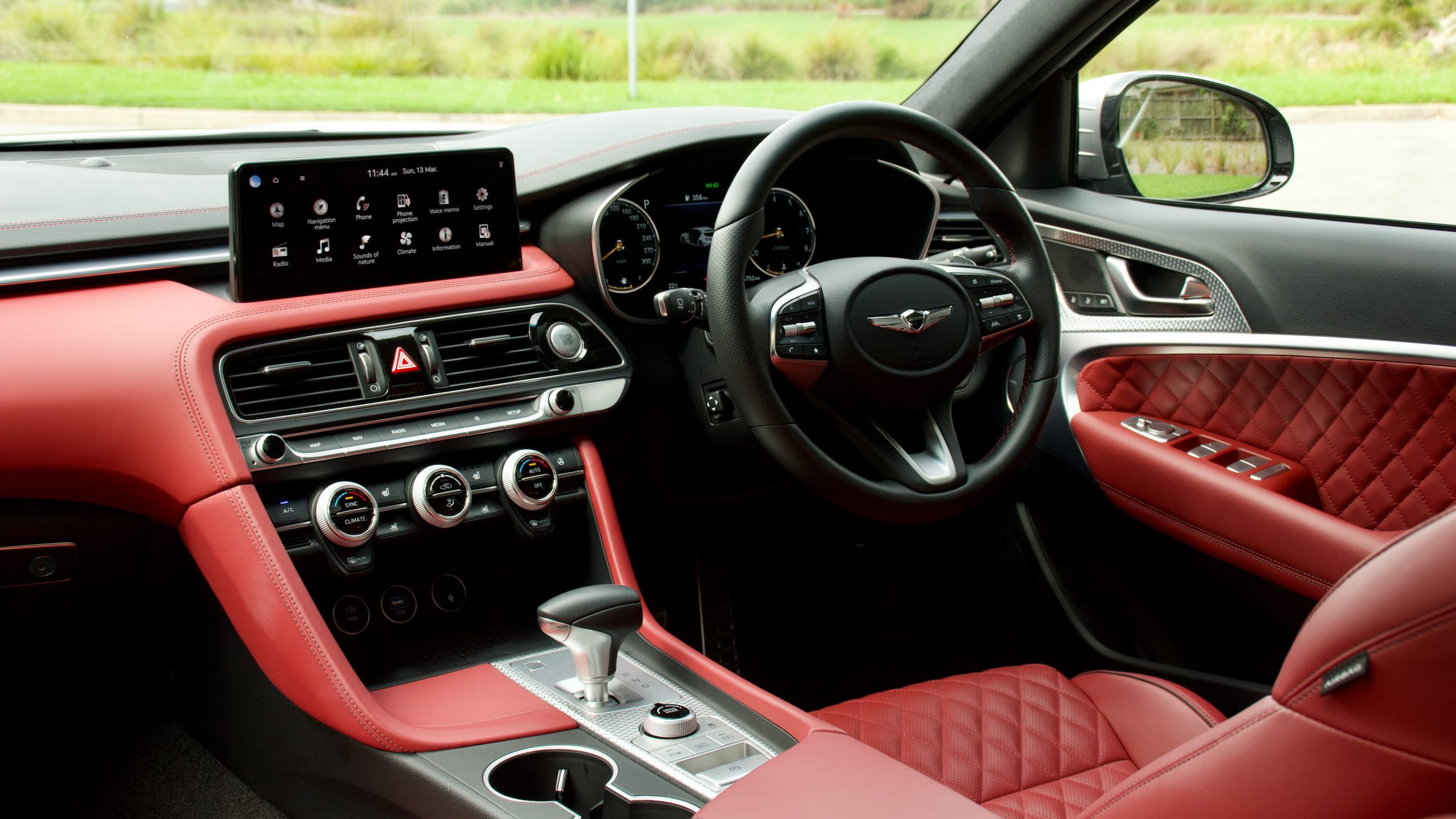
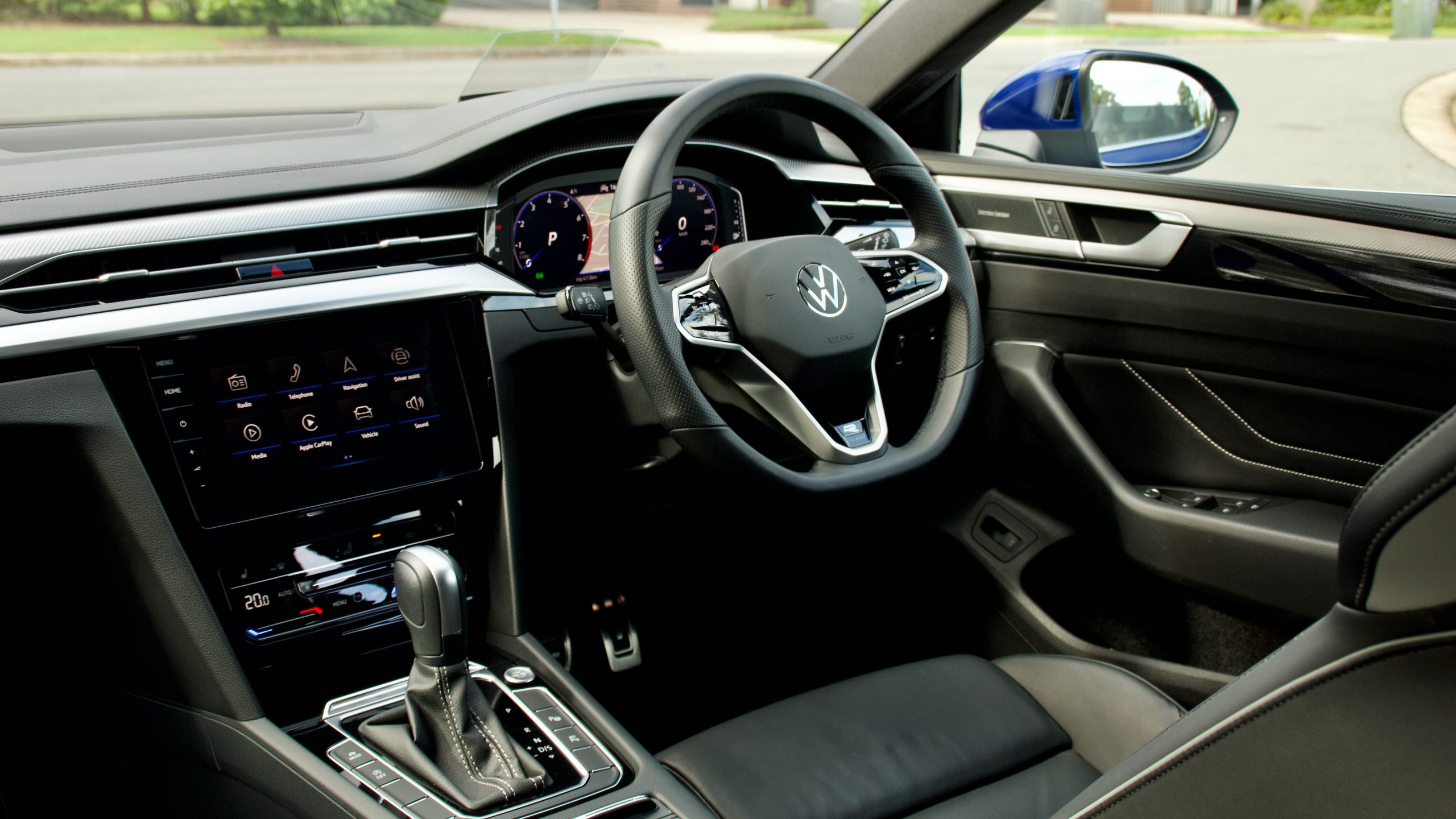
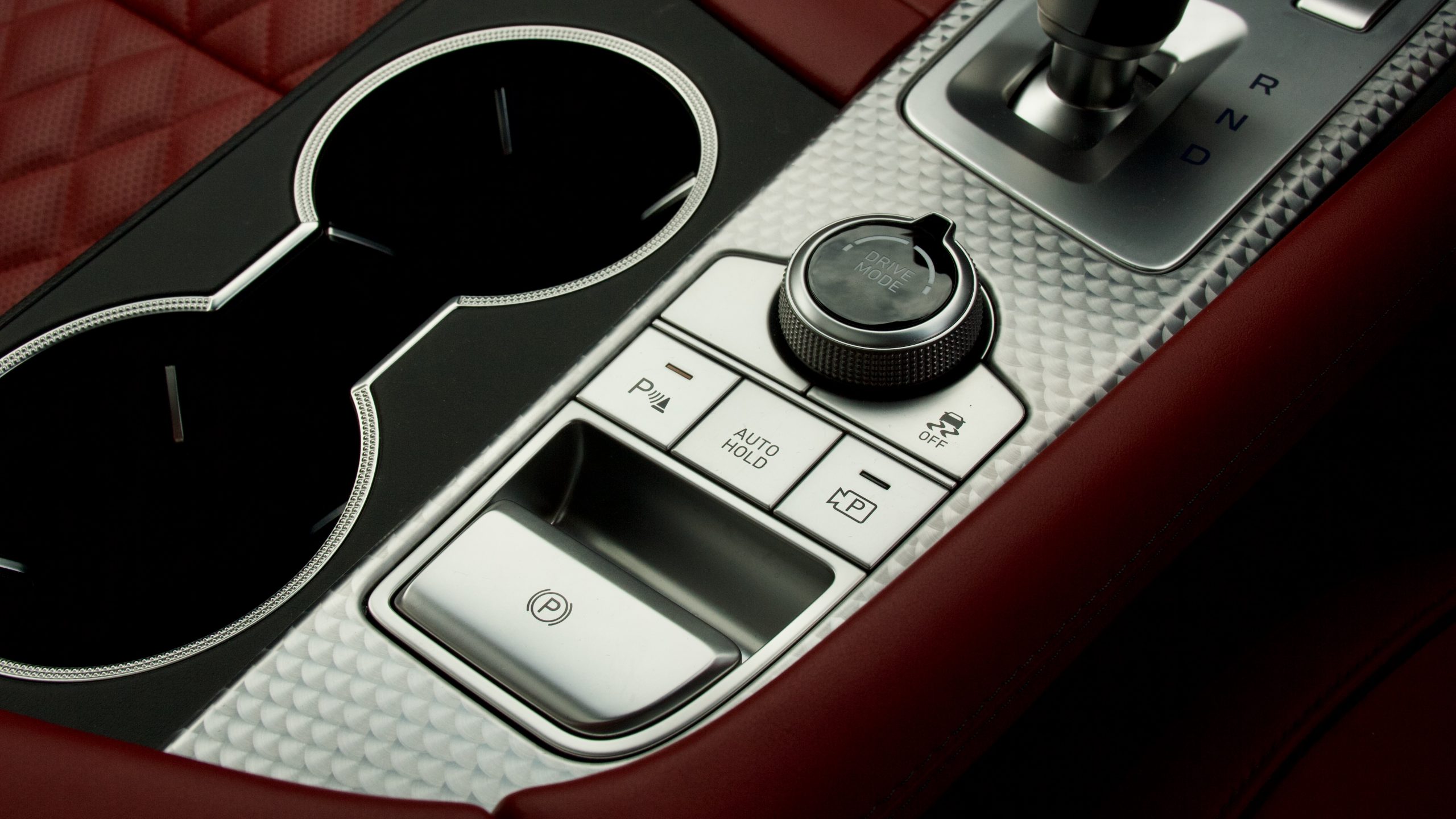
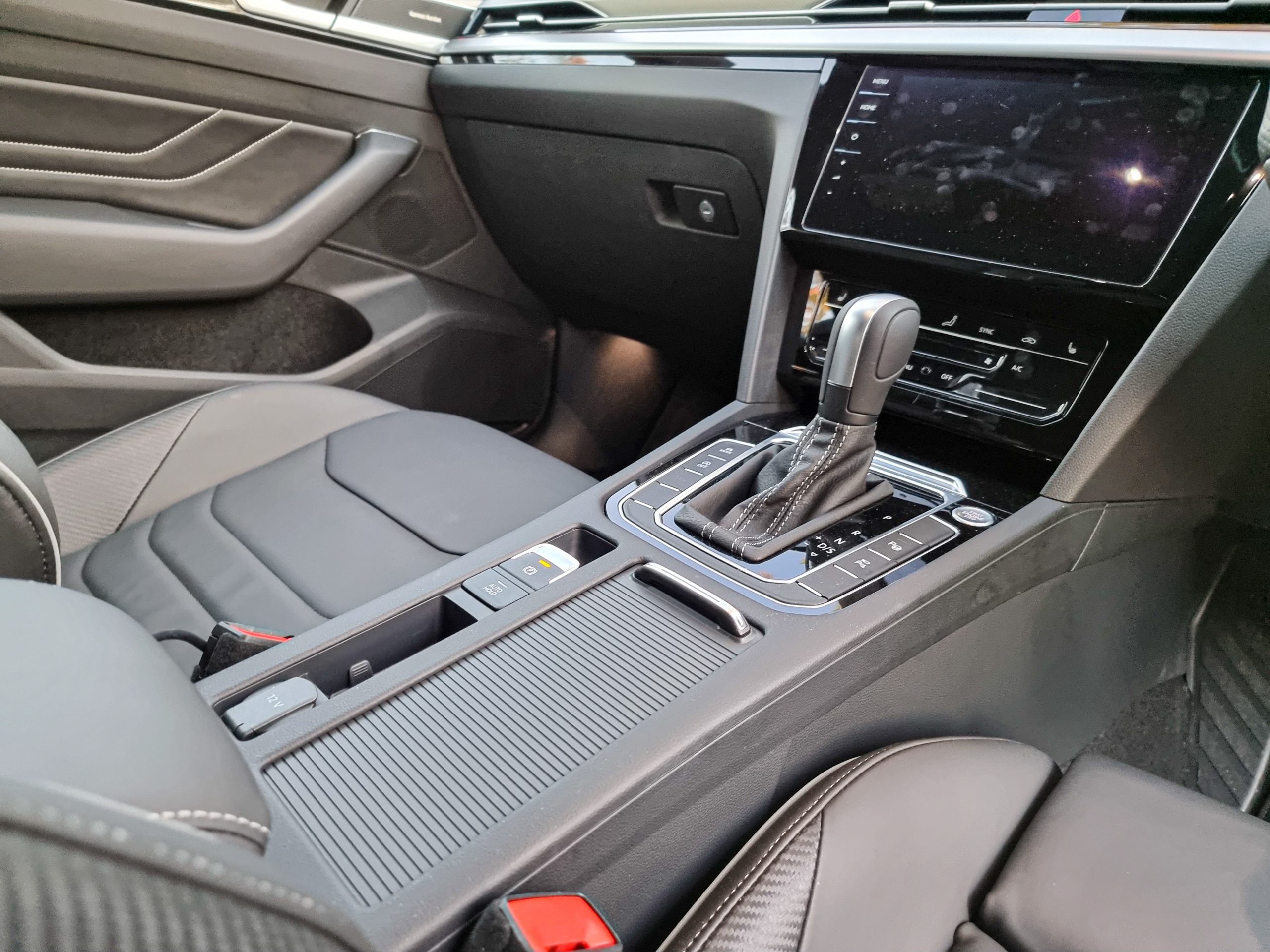
Safety equipment on both cars include multiple airbags (including rear side, driver’s knee and a front centre unit in the G70), auto emergency braking (AEB) with pedestrian detection, auto rear braking, Matrix adaptive high beam functionality, adaptive cruise control with stop and go functionality, blind-spot monitoring with rear cross-traffic alert, a heads-up display (the G70’s is a proper projection onto the windscreen, whereas the Arteon’s is projected onto a plastic window above the dials), lane keep assist with lane trace assist, a 360-degree parking camera, driver attention monitoring, front and rear parking sensors and an alarm.
Over the G70, the Arteon features larger 20-inch wheels, tri-zone climate control, wireless Apple CarPlay and Android Auto, automatic post-collision braking and automatic parking.
Over the Arteon, the G70 features a sunroof, cooled front seats, a wireless phone charger, remote-folding rear seats, remote start, a massaging front passenger seat, speed sign recognition, a heated steering wheel, a variety of interior colours and premium paint.
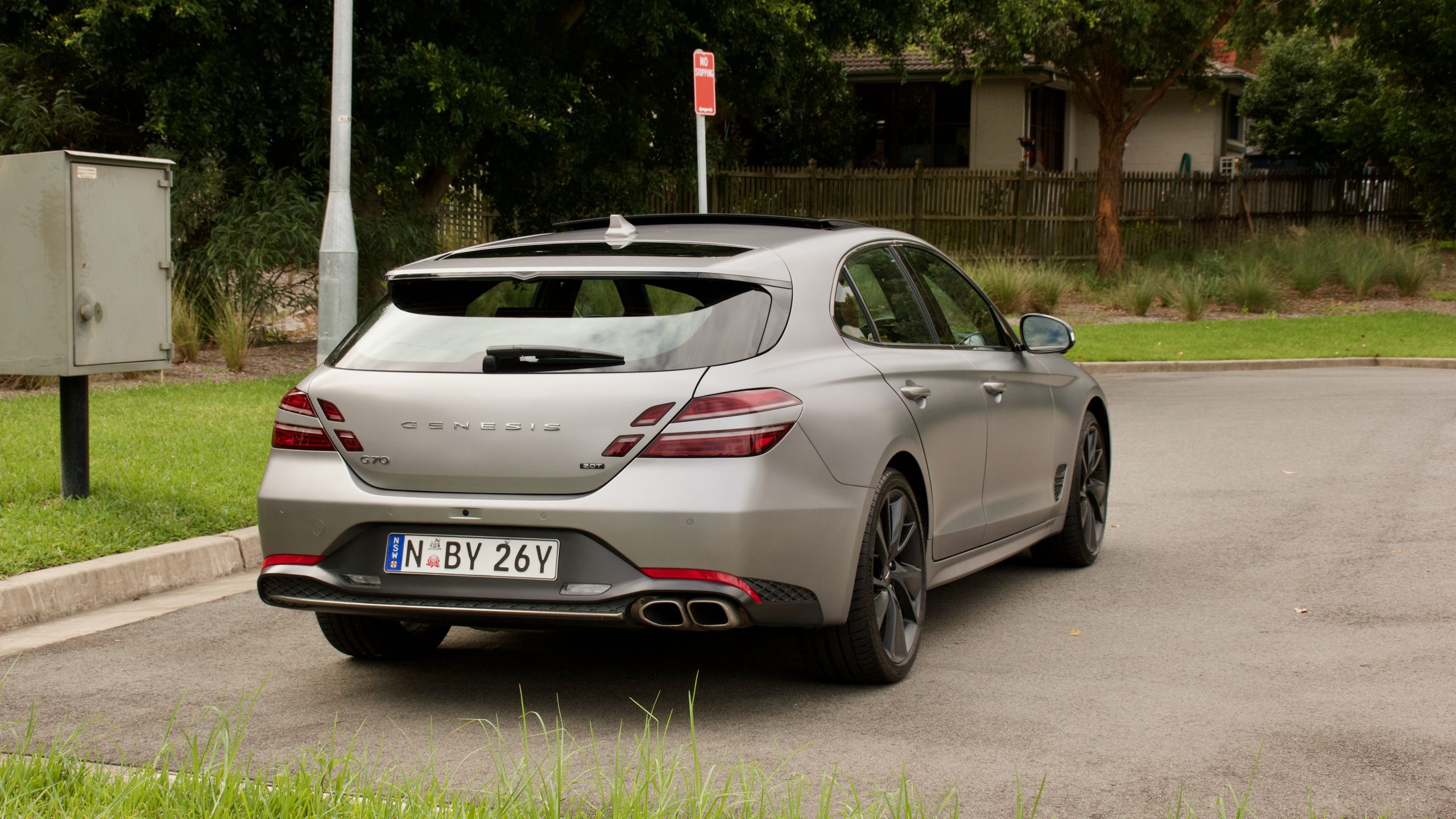
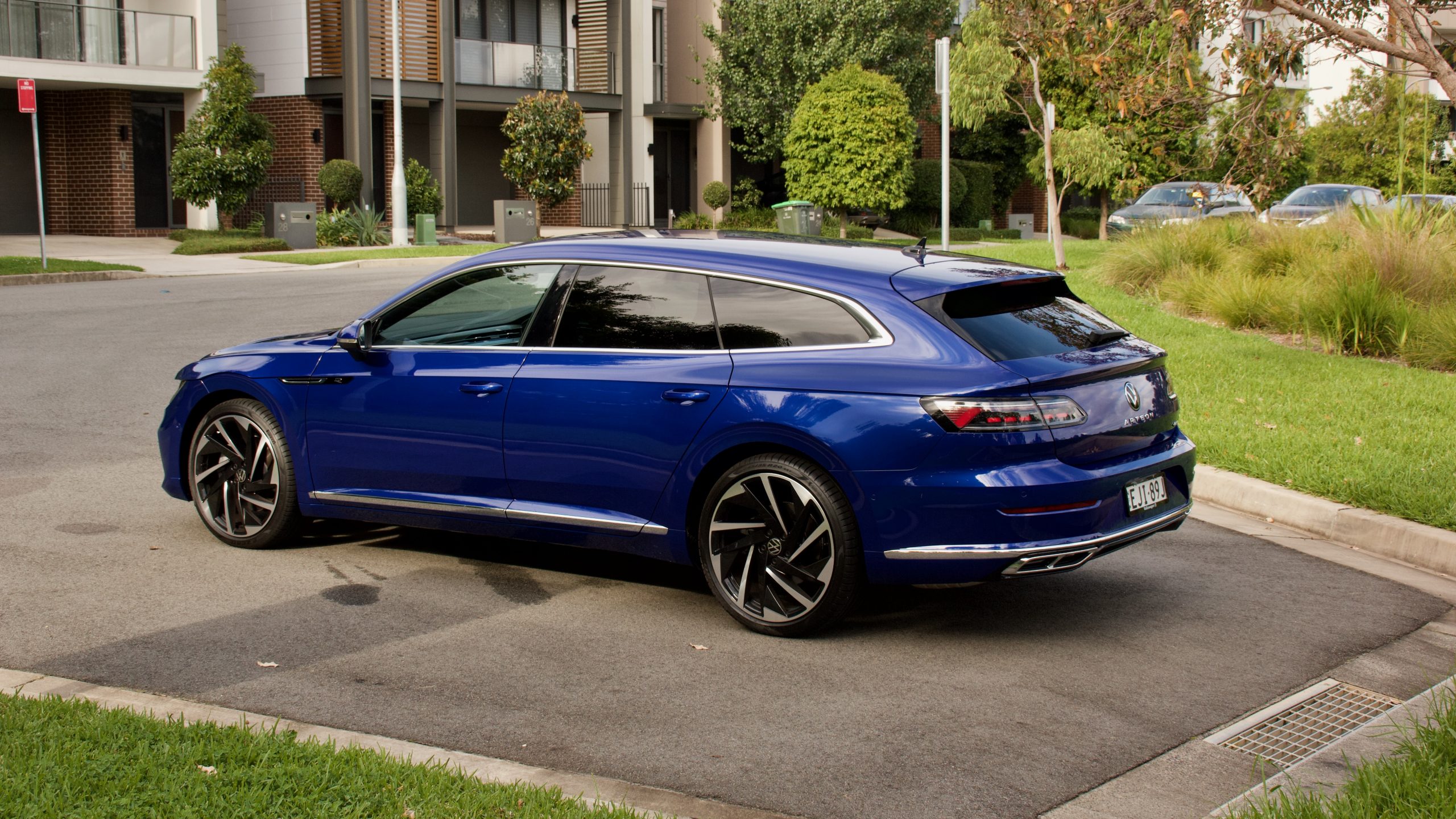
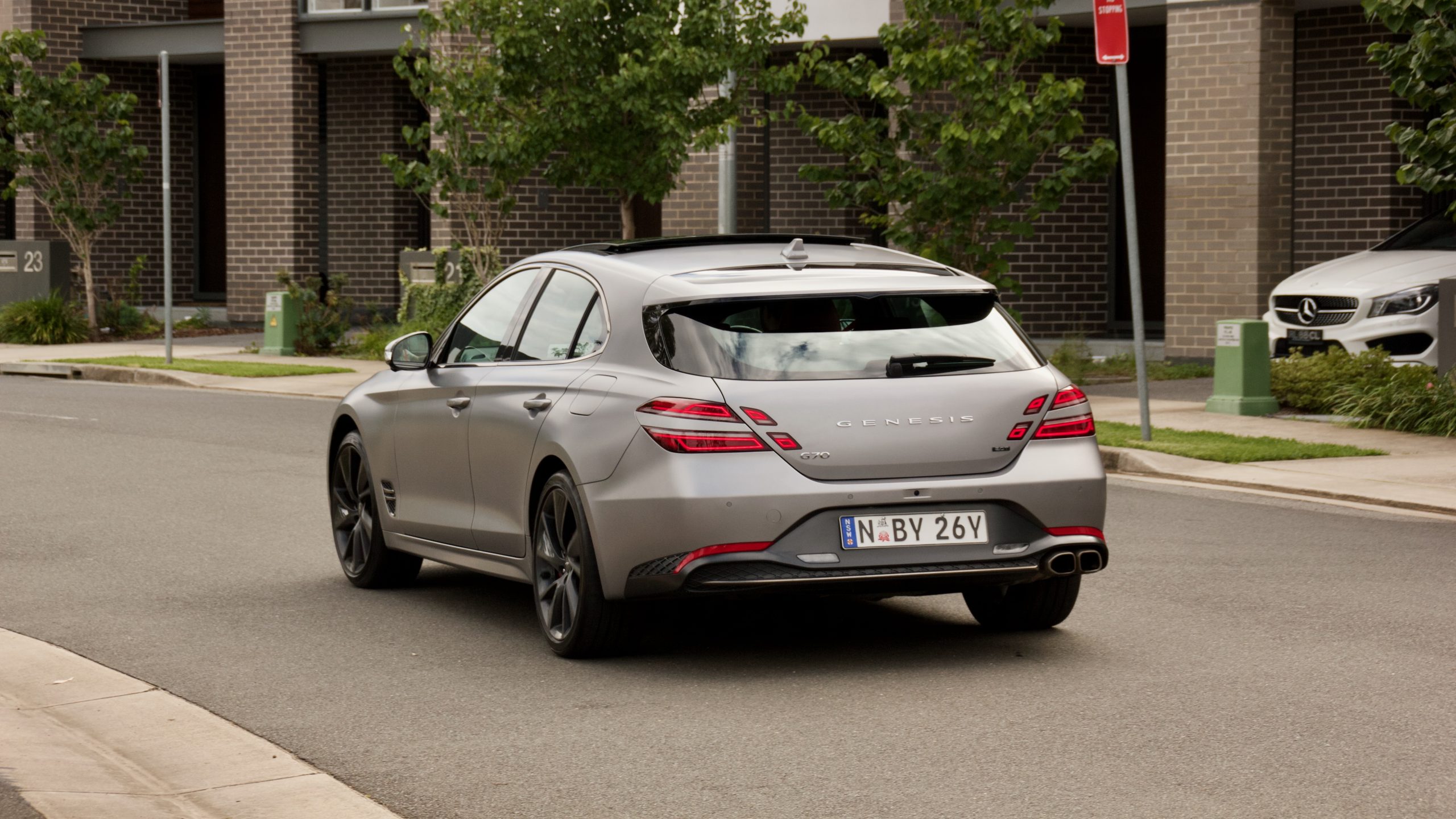
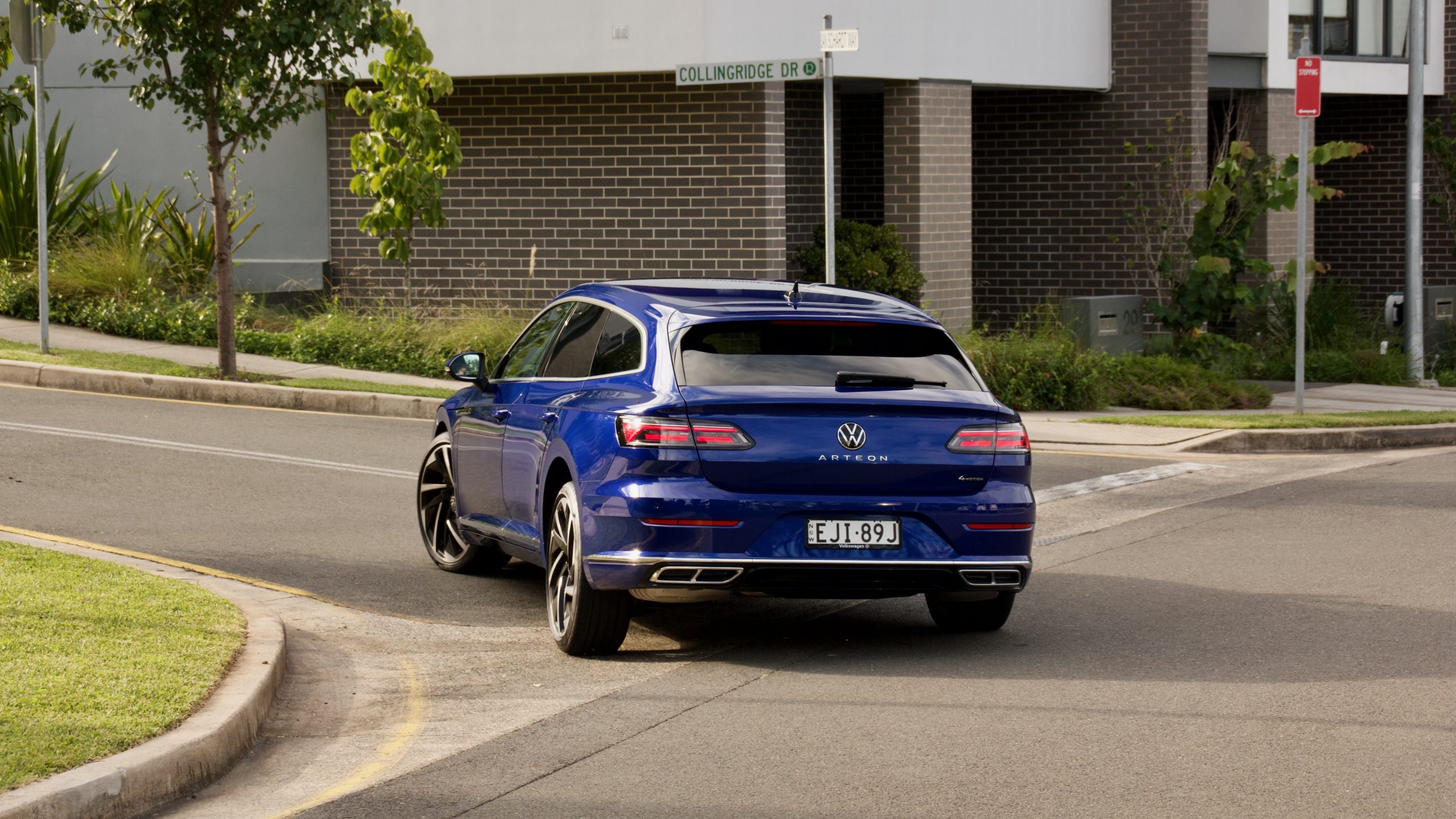
The Arteon is available in ‘Deep Black’, ‘Kings Red’, ‘Pyrite Silver’, ‘Manganese Grey’ and our test car’s ‘Lapiz Blue’ for no extra cost – ‘Oryx White’ is available for a further $900. The sole interior colour option is black, while a panoramic sunroof is a further $2,100 but it really should be standard.
There’s a big degree of personalisation for the G70 Shooting Brake, through the long list of available colours and interior trims. All metallic paint options are no-cost, and include ‘Vic Black’, ‘Capri Blue’, ‘Tasman Blue’, ‘Valencia Gold’, ‘Hallasan Green’, ‘Makalu Grey’, ‘Siberian Ice’, ‘Cavendish Red’, ‘Havana Red’, Savile Silver’ and ‘Uyuni White’. Matte paint options (which cost an extra $2,000) include ‘Verbier White’, ‘Makulu Grey’ and our test car’s ‘Bond Silver’.
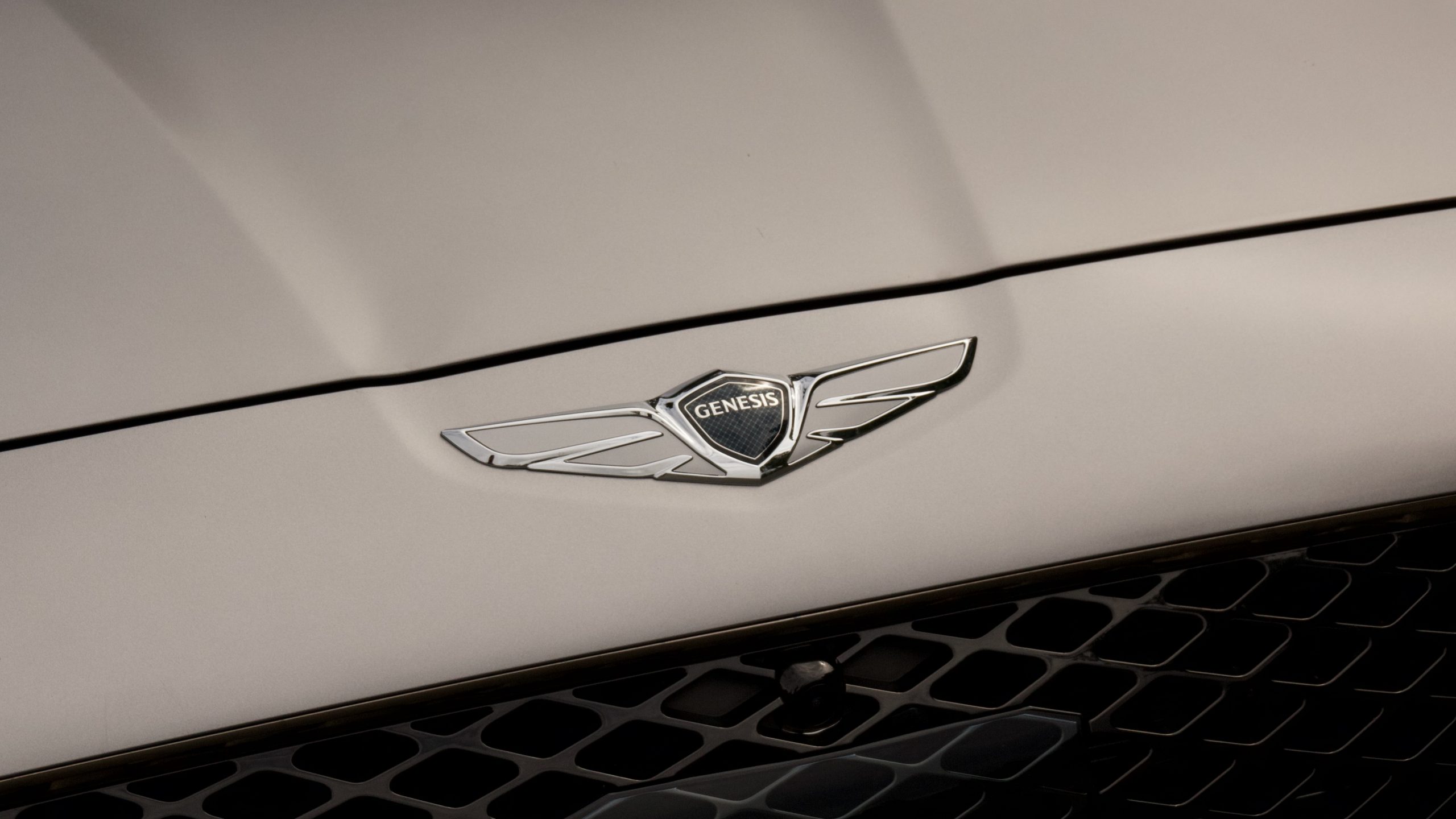
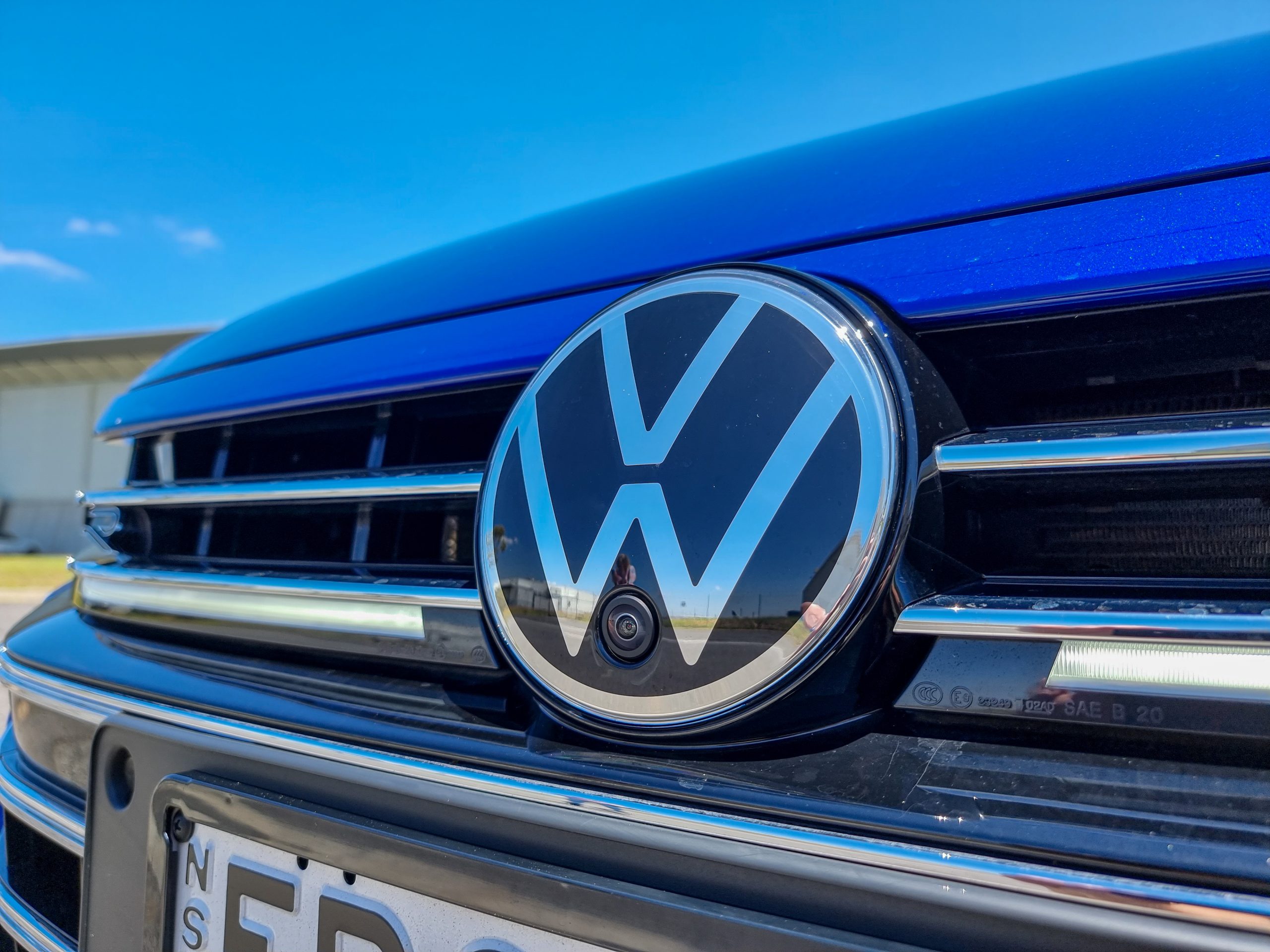
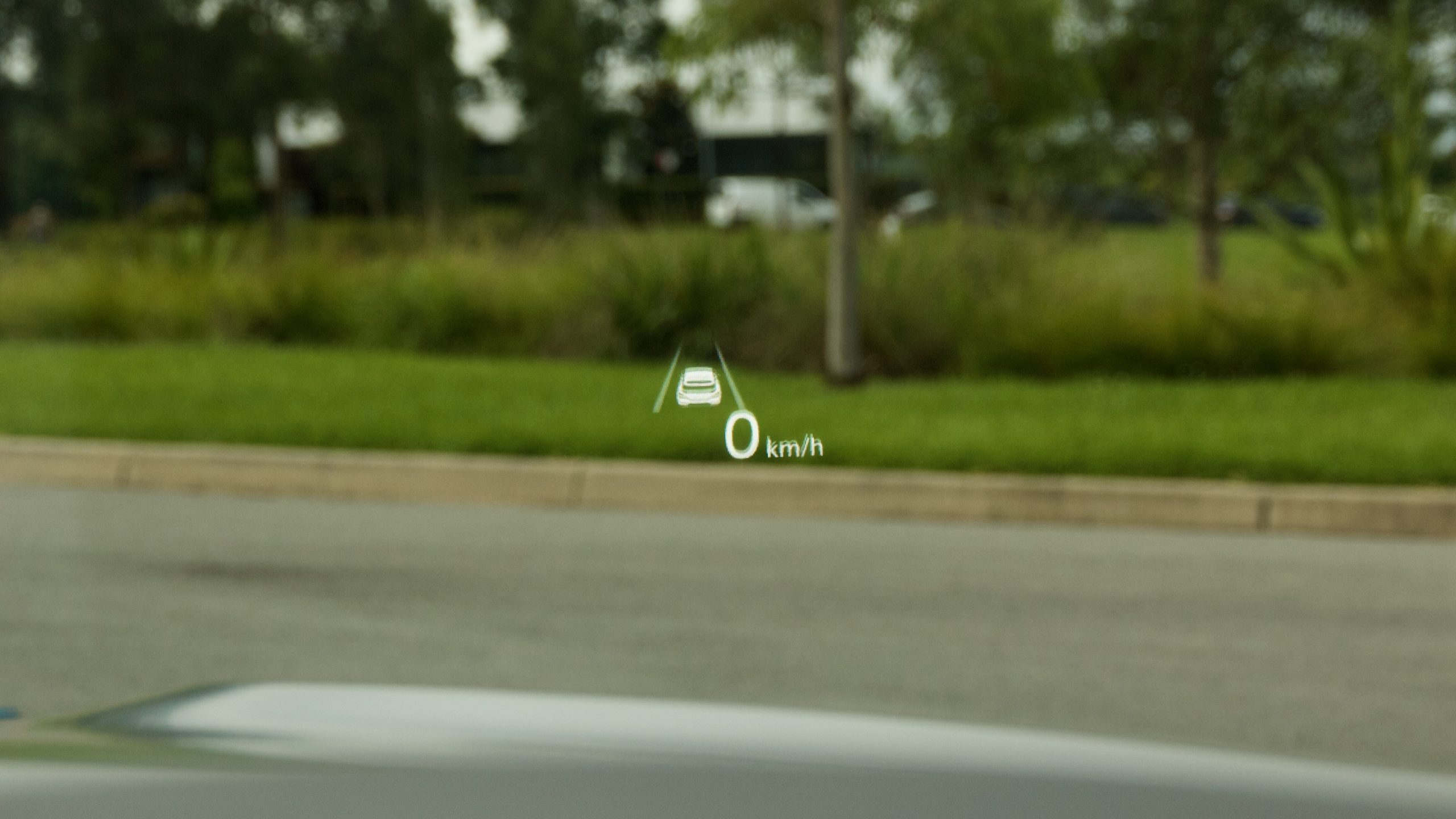
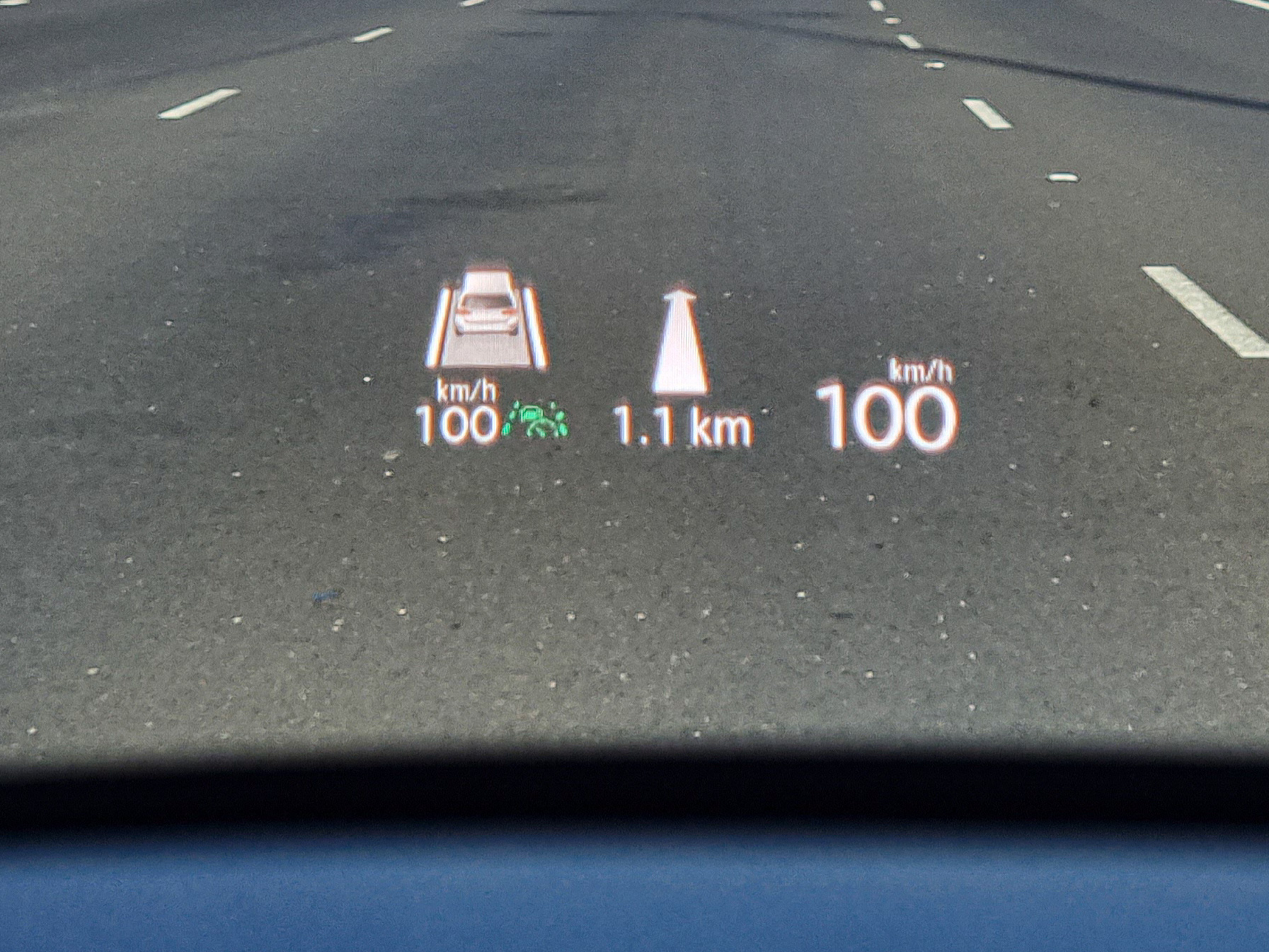
Interior colour options include black, burgundy, tan, beige, grey and our test car’s red, all for no extra cost, which gives it an advantage over the Arteon for those who like interior colours. We’d skip the matte paint of our test car for ‘Tasman Blue’ over the tan interior for a particularly rich look. Also available is the no-cost Sport Line package that was fitted to our test car, which adds unique 19-inch wheels, a sportier grille, dark chrome exterior highlights, metal pedals and ‘sport’ quilted upholstery.
Price & Equipment winner: Volkswagen Arteon 206TSI Shooting Brake
Performance & Economy:
Under the bonnet of both cars are 2.0-litre turbocharged four-cylinder petrol engines, which are matched to automatic transmissions – a seven-speed dual-clutch unit in the Arteon and an eight-speed torque converter in the G70. The Arteon pumps out 206kW (at 6,600rpm) of power and 400Nm of torque (between just 2,000rpm and 4,950rpm), which easily out-muscles the G70’s 179kW (at 6,200rpm) and 353Nm (between 1,400rpm and 3,500rpm).
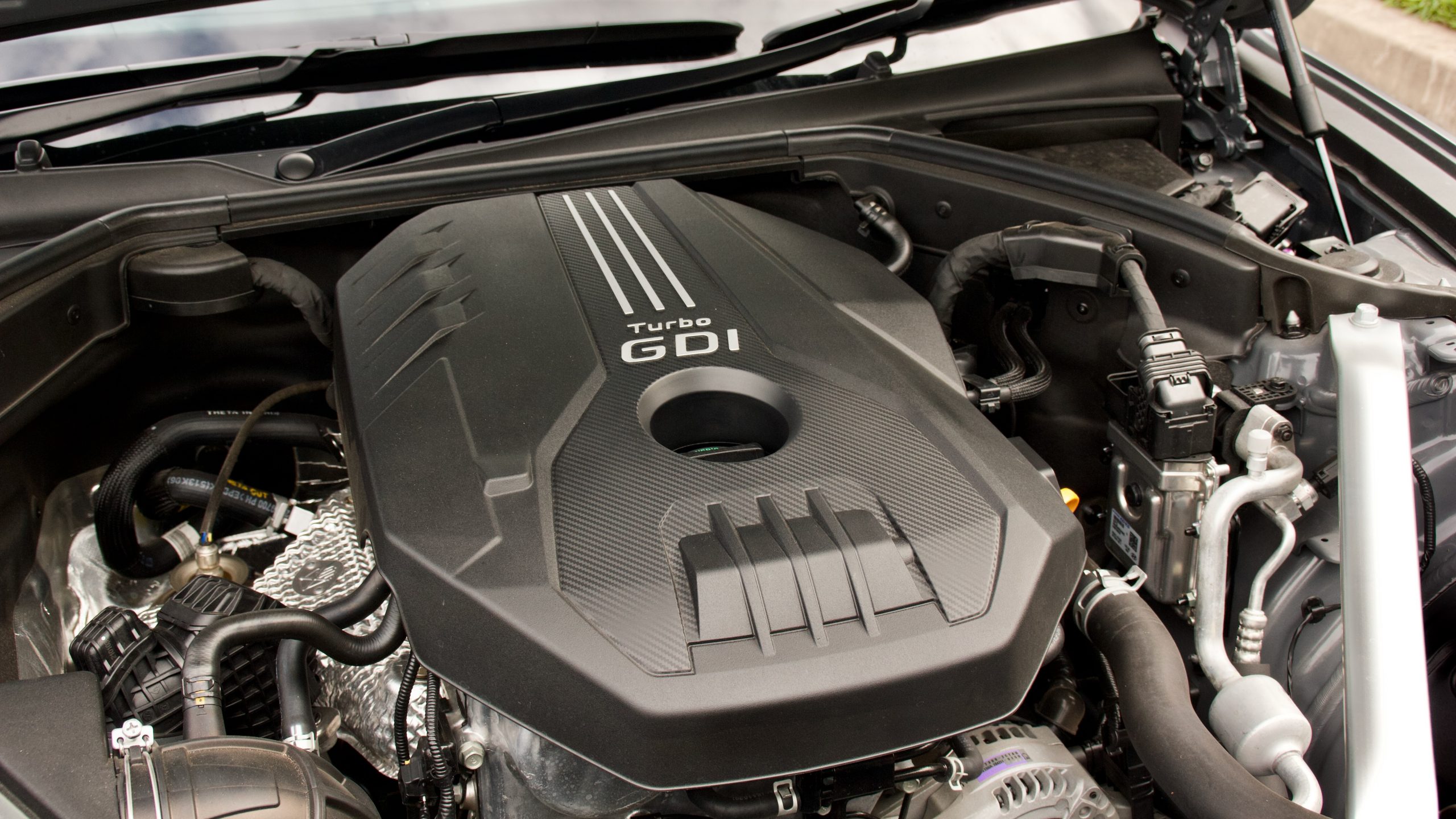
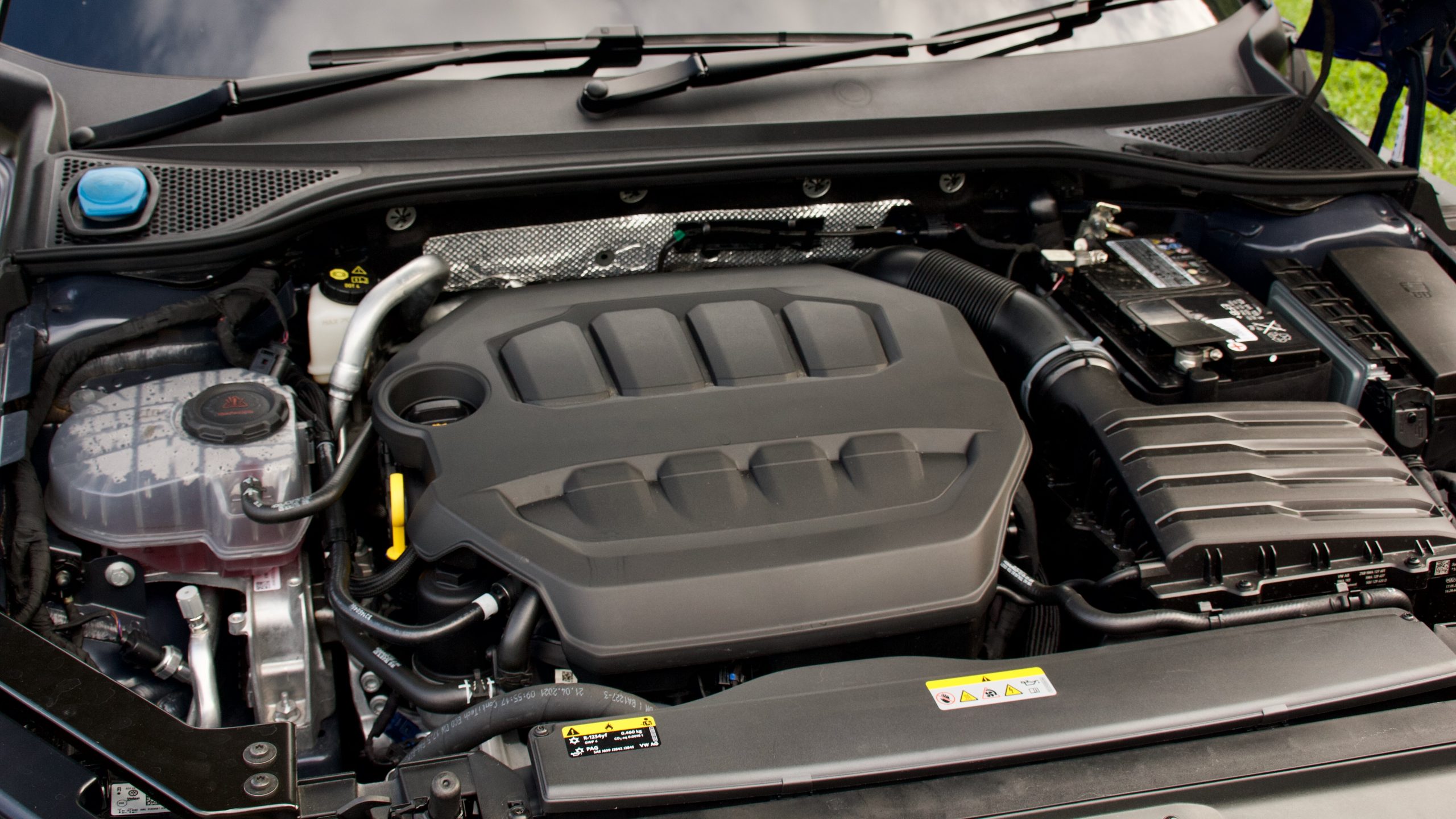
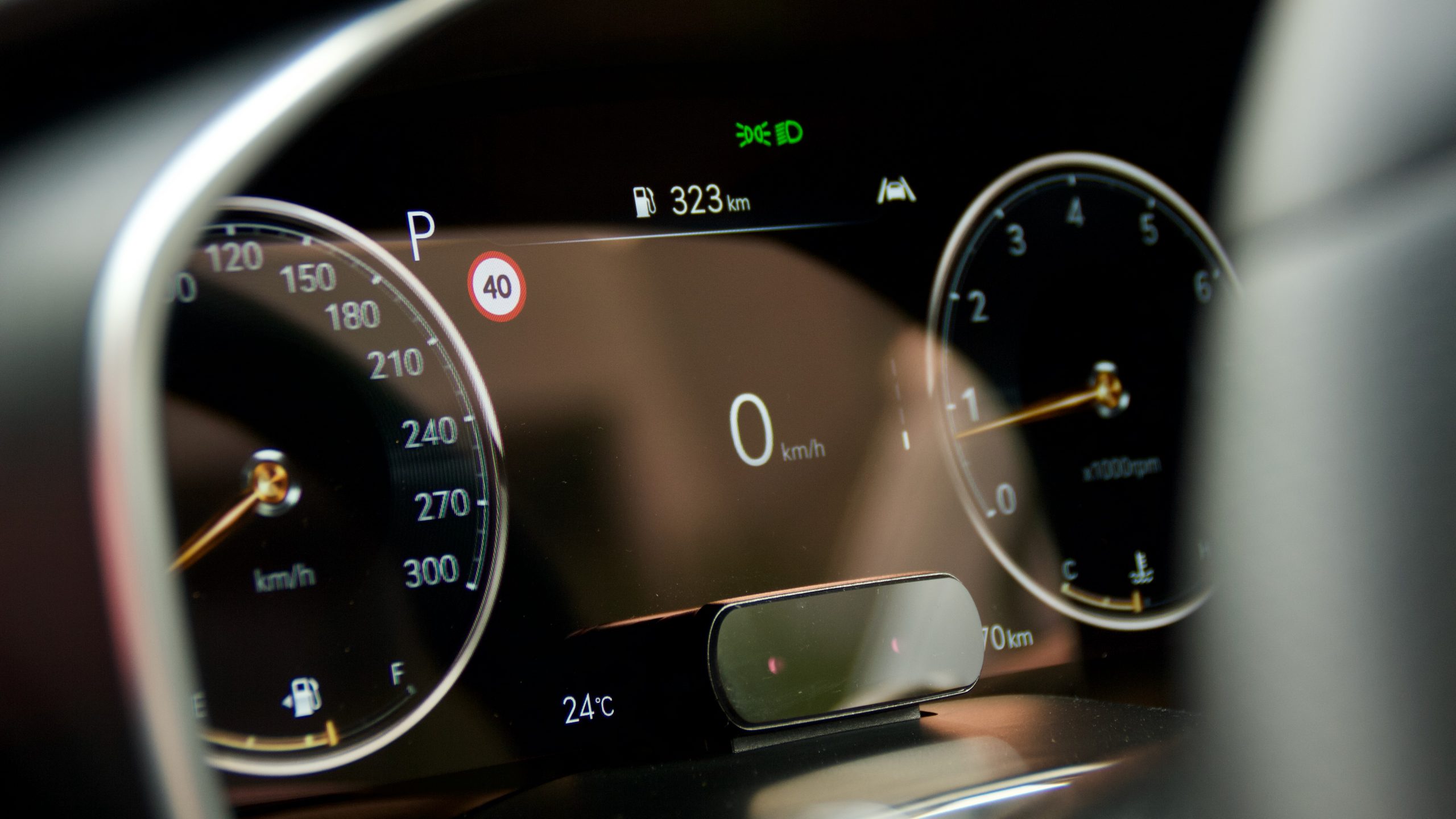
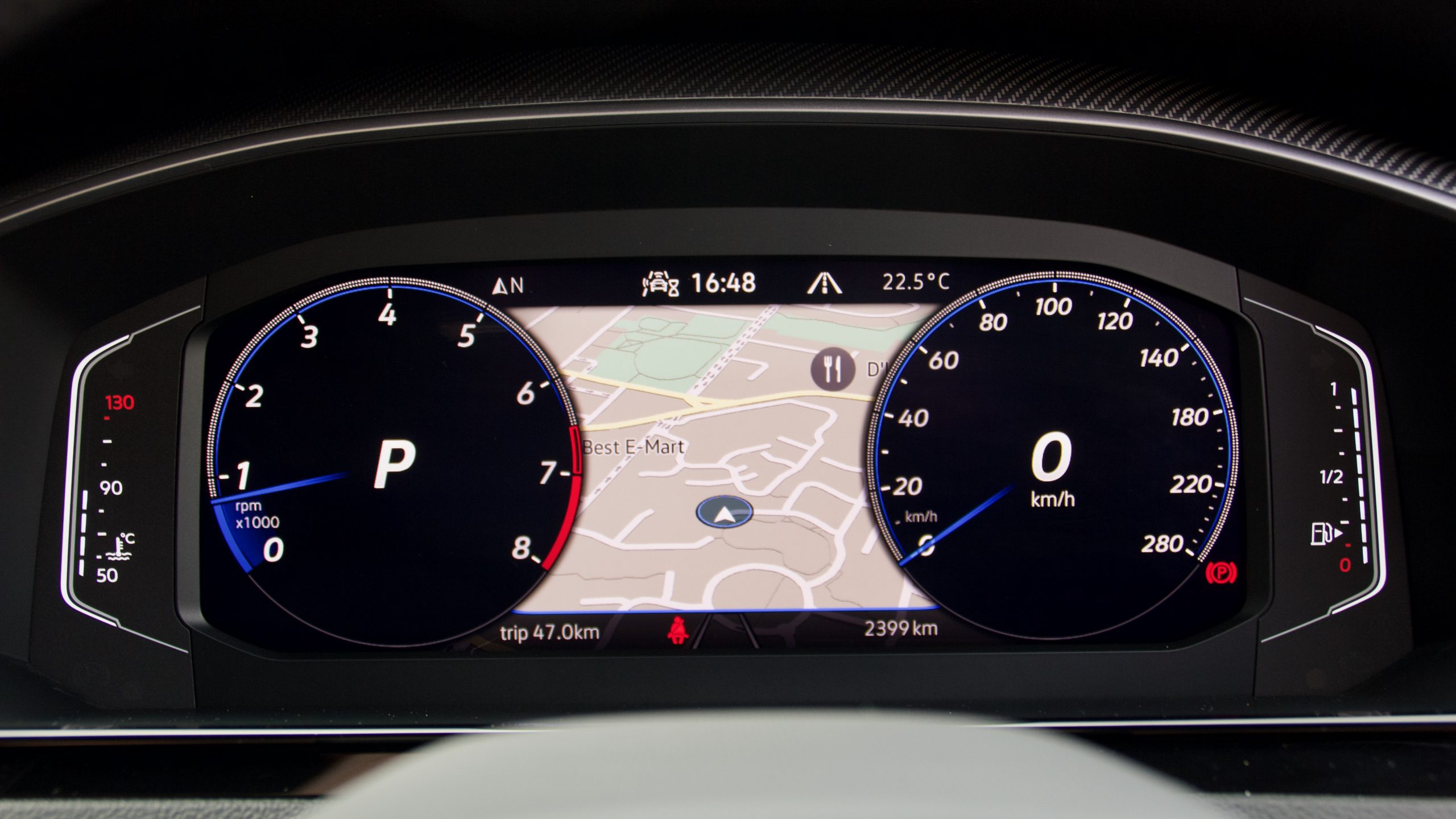
Volkswagen claims that the Arteon 206TSI Shooting Brake sprints from 0 to 100km/h in a quick 5.6 seconds, which is only 0.8 seconds faster than the G70 (6.4). But in reality, the difference between the two feels greater as the Arteon is noticeably more urgent throughout the rev range. The Arteon’s engine also sounds nicer than the G70’s, with a nicely tuned growl making itself known in the upper revs.
While the Arteon uses a seven-speed dual-clutch ‘DSG’ automatic transmission, the G70 uses an eight-speed torque converter auto and it’s noticeably smoother than the Volkswagen’s transmission. At low speeds, where the G70 shifts almost imperceptibly, the Arteon stumbles and is confused in the typical dual-clutch auto fashion. But at higher speeds and when you’re on a back road, the DSG is quicker at shifting and the transmission almost feels like an extension of your arm.
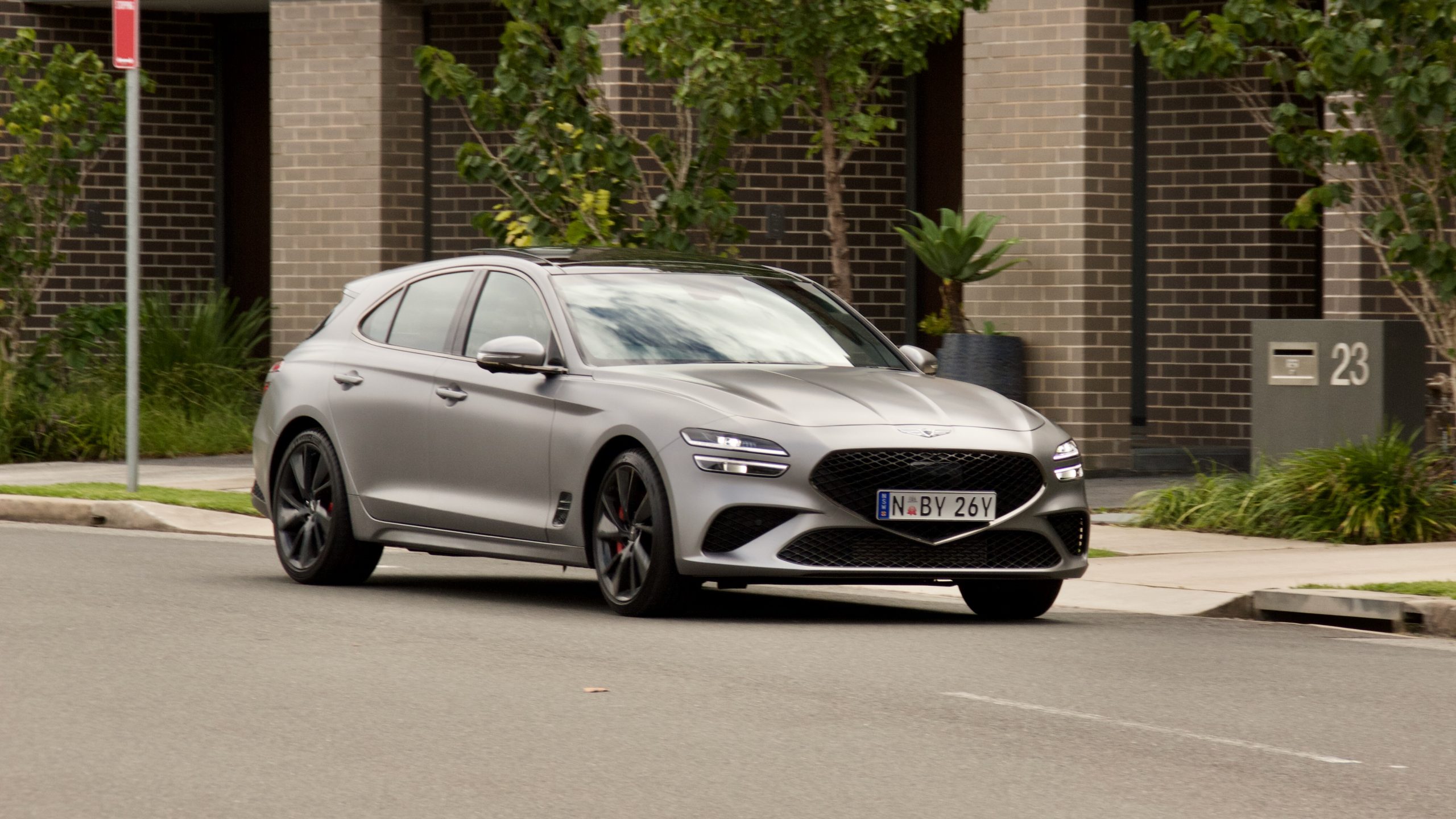
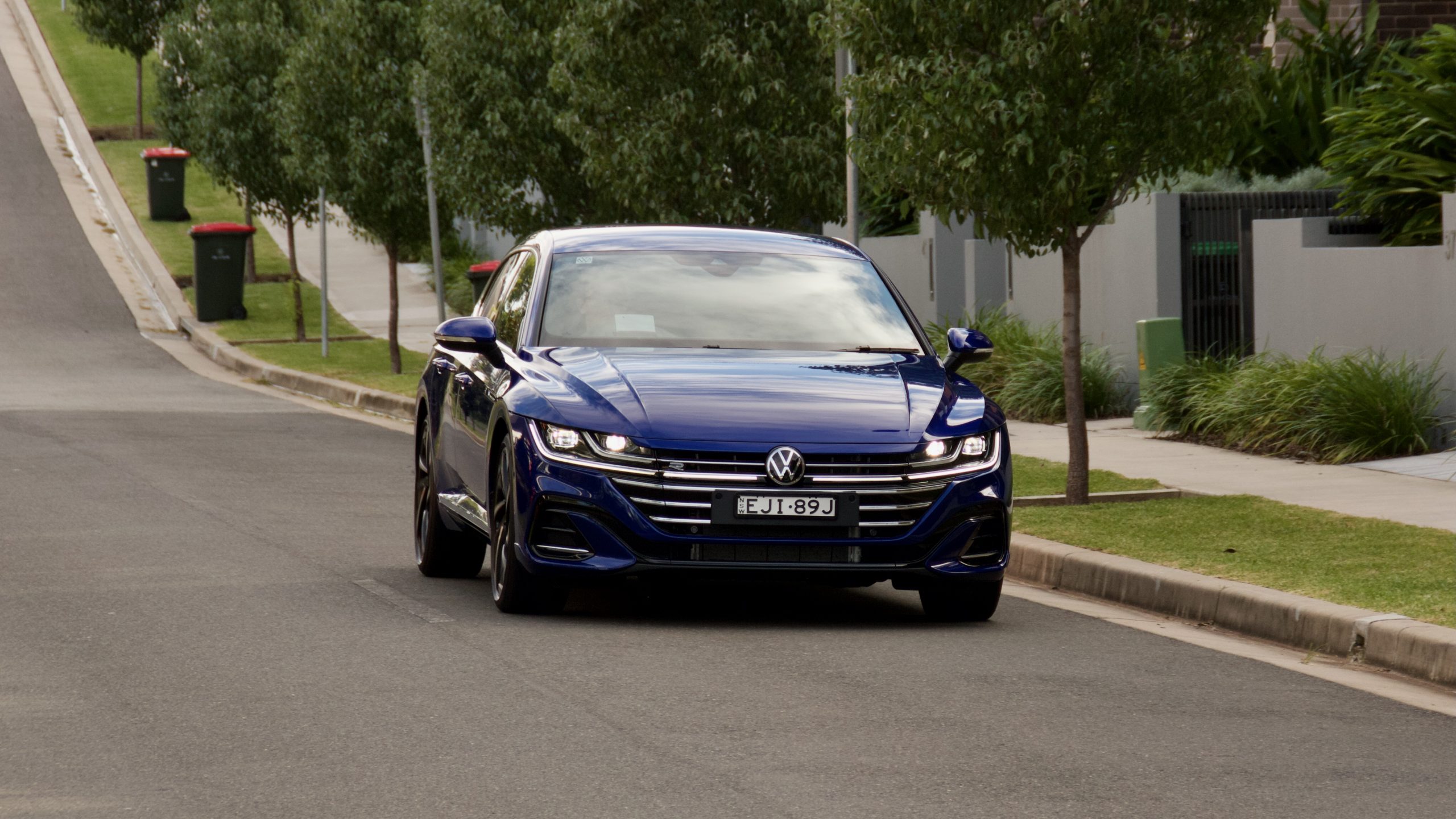
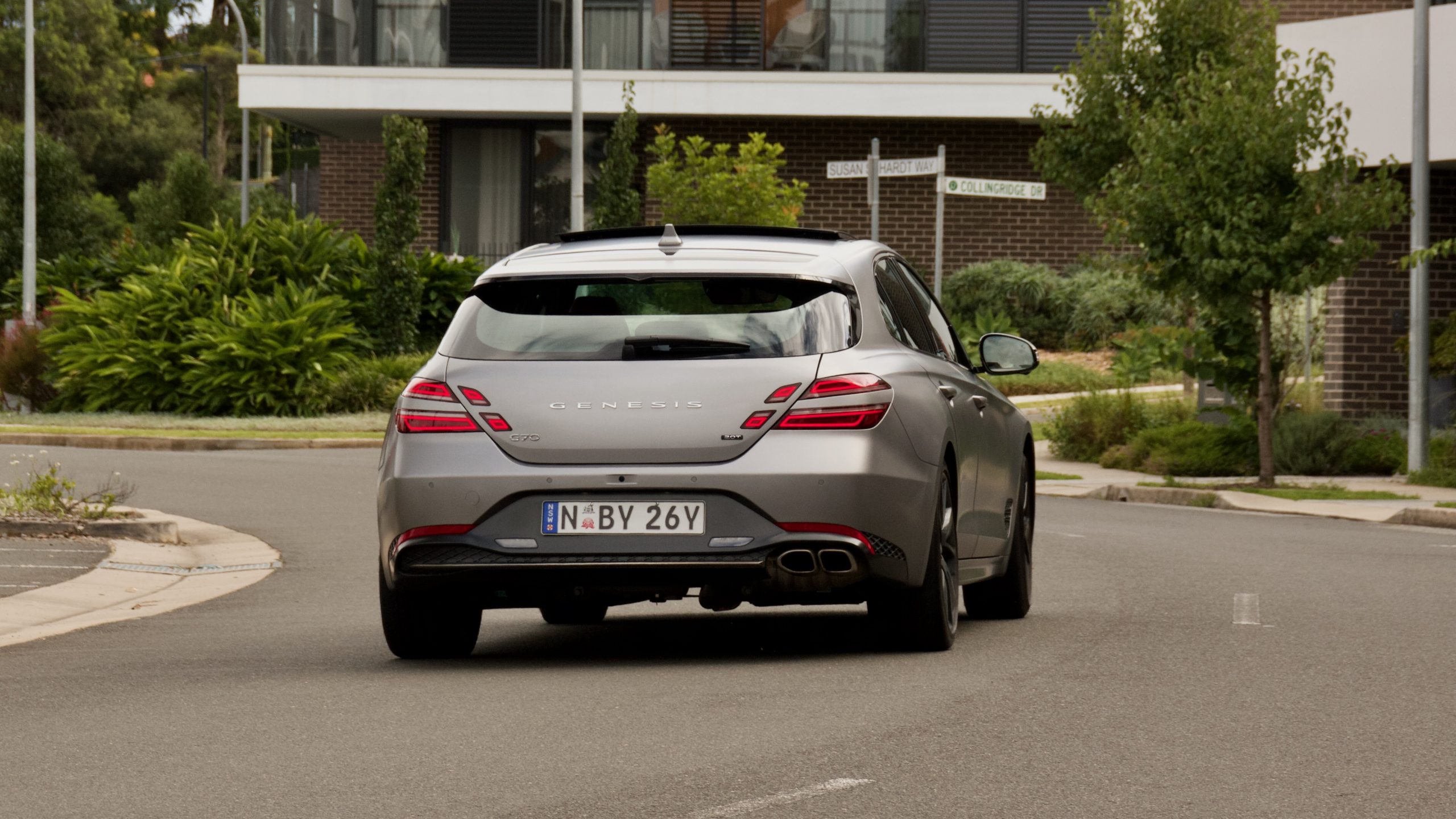
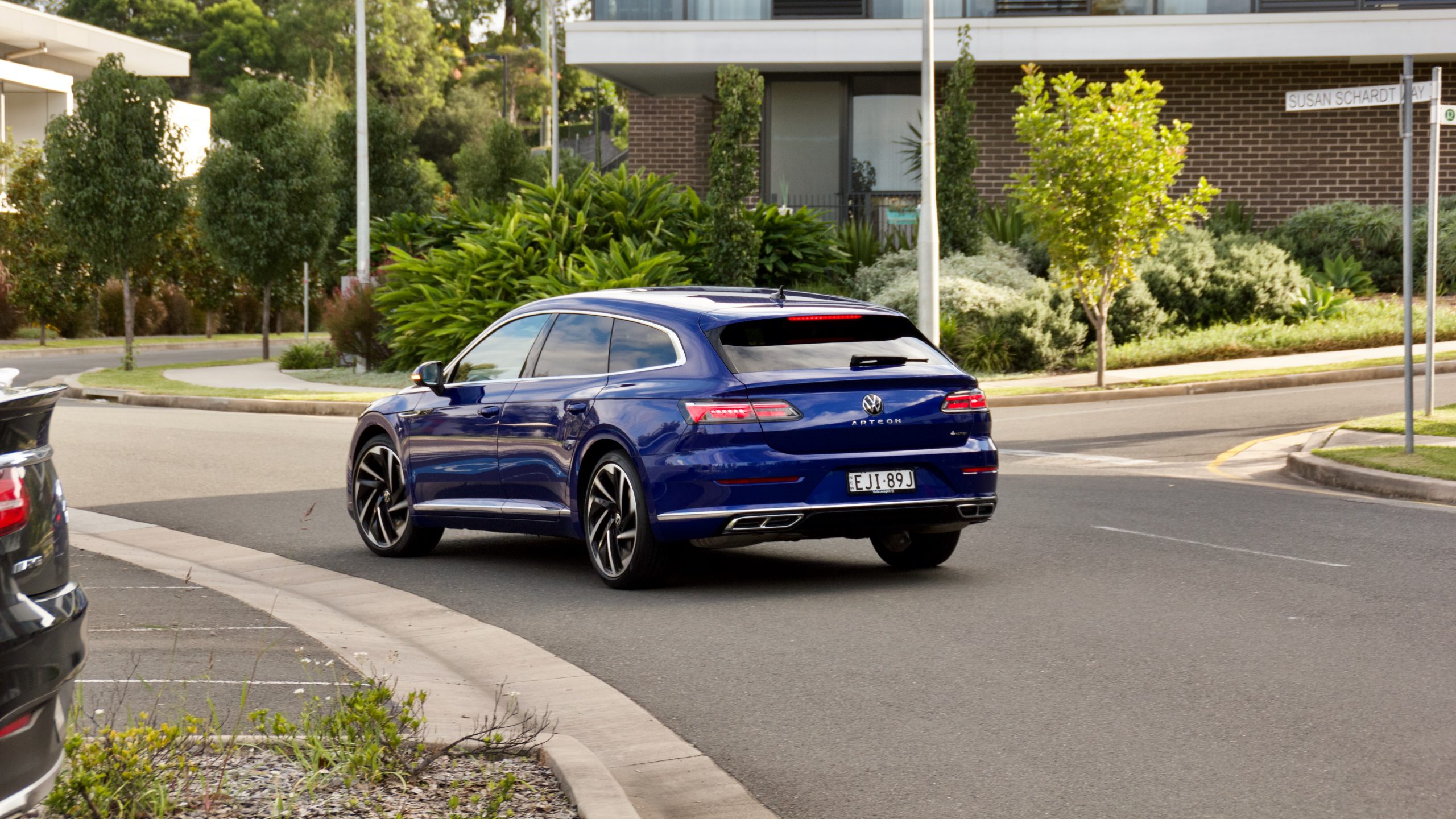
In terms of fuel economy, Volkswagen claims that the Arteon 206TSI Shooting Brake will use 7.7L/100km and the claimed average for the G70 Shooting Brake is 9.1L/100km, which is 1.4L/100km more. That difference was around what we saw in the real world, with the Arteon recording 10.1L/100km and the G70 11.3L/100km in our combined testing. The Arteon must use 98RON premium unleaded – it has a petrol particulate filter that can only handle 98RON in Australia – whereas the G70 can run on slightly less expensive 95RON. The Arteon has a 66-litre fuel tank versus the G70’s 60-litre tank.
Performance & Economy winner: Volkswagen Arteon 206TSI Shooting Brake
Ride & Handling:
Both the Volkswagen Arteon and Genesis G70 drive well, regardless of their bodystyle. They’re quiet, comfortable and excel at long-distance touring thanks to low road noise levels and comfortable seats. But dynamically, the G70 is the car to choose – not least because of its rear-wheel drive platform, but because it just feels more like a driver’s car. The steering has a touch more weight to it, you sit lower in the car with a sportier driving position and it feels sharper and more fun than the Arteon from behind the wheel.
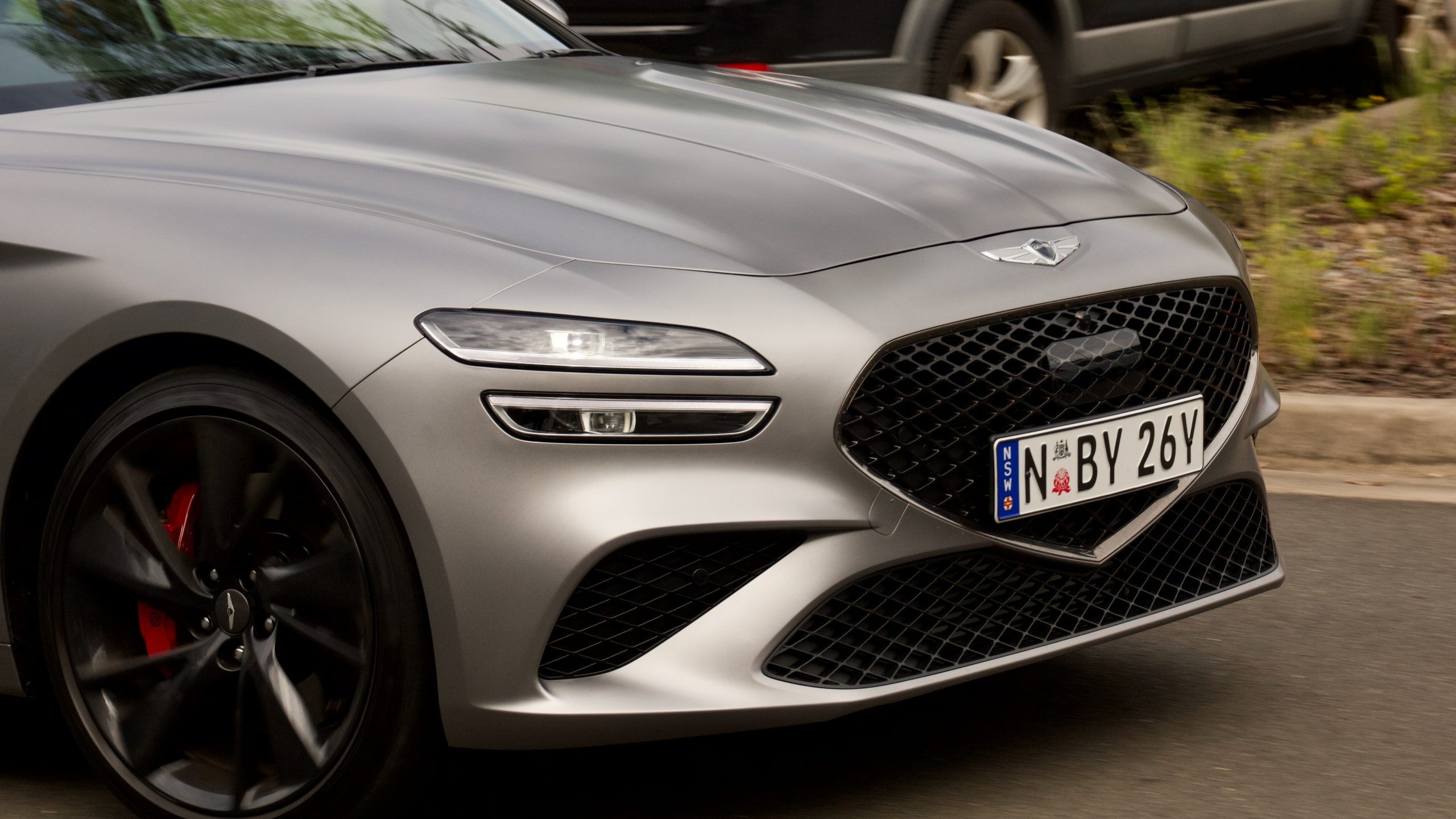
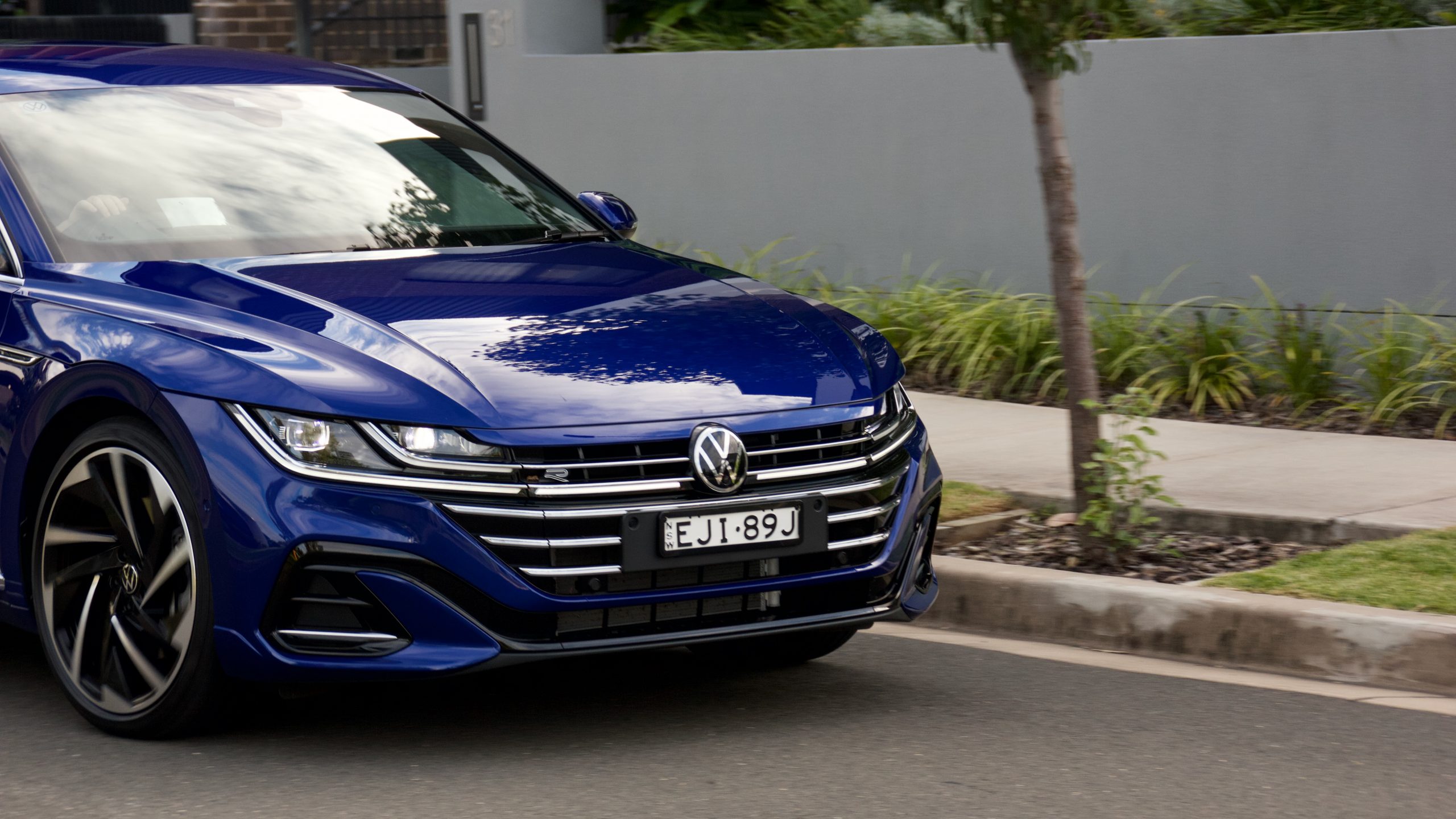
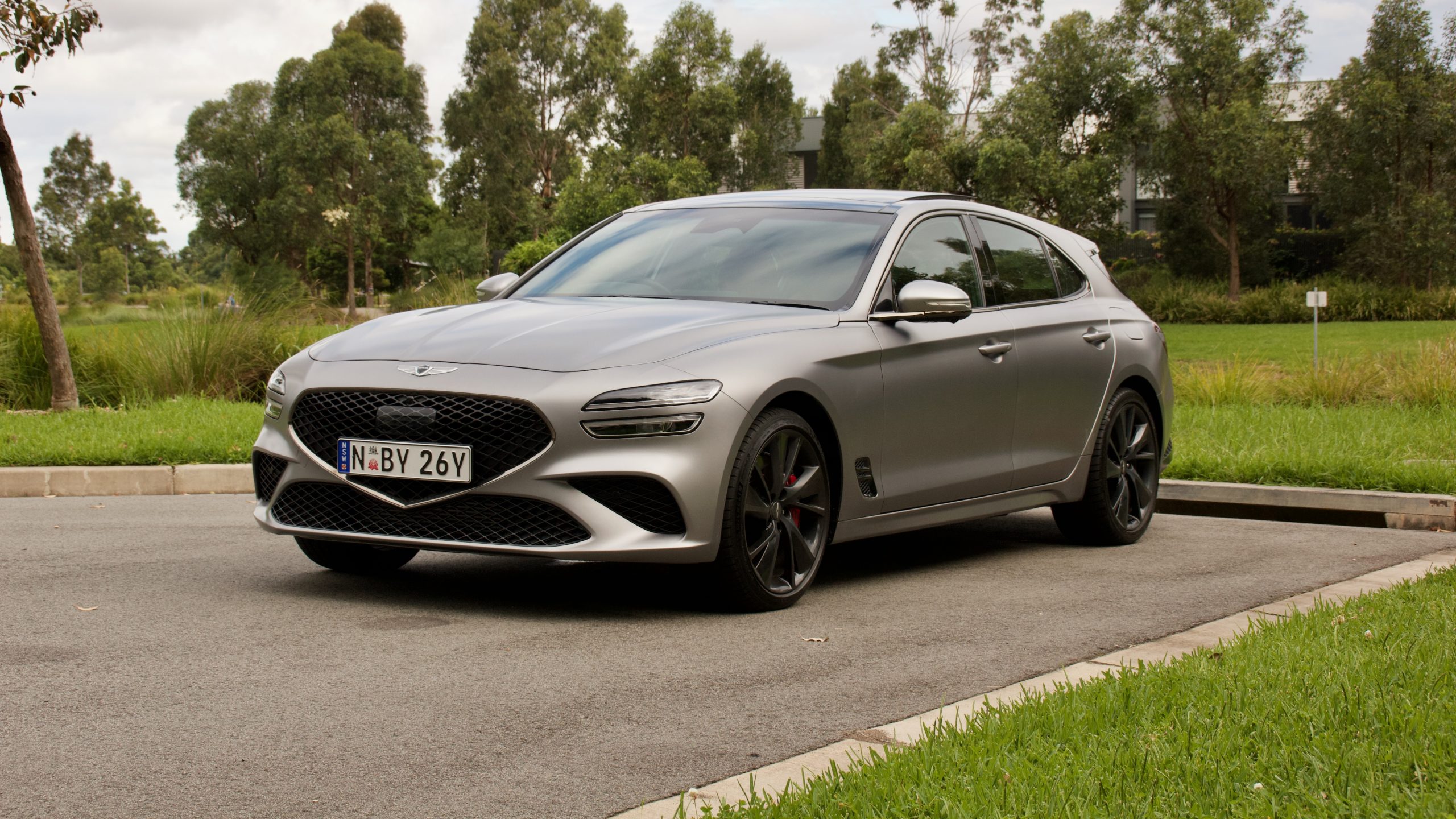
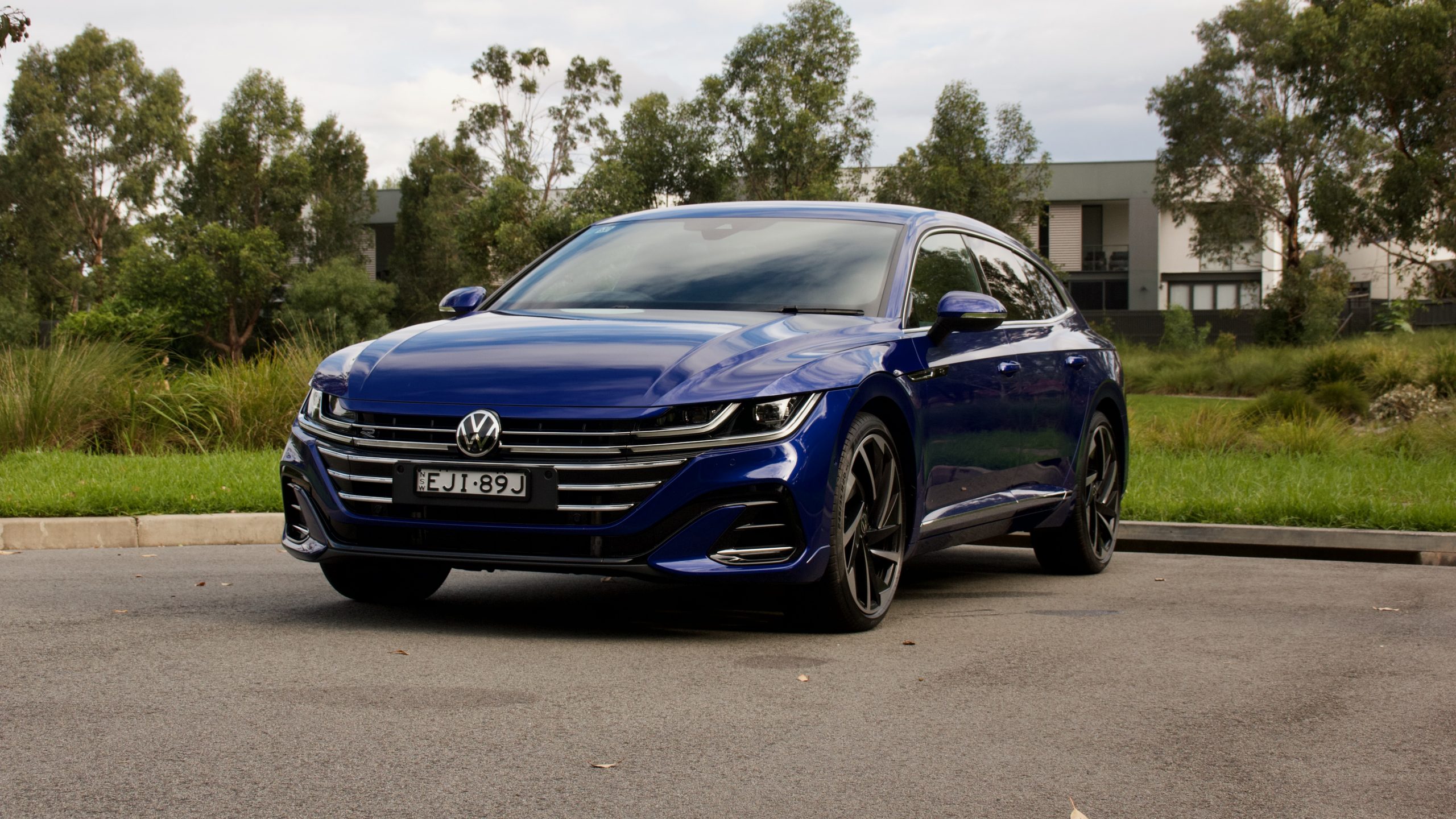
It’s the same story with the ride quality of both cars – while both cars have adaptive dampers, the G70’s locally tuned suspension settings deal with our rubbish roads better, while the smaller 19-inch wheels of the G70 are less sharp to look at than the Arteon’s 20s, they’re also less sharp where bumps are concerned. In comfort mode, the Arteon feels too floaty and the G70’s body control is just better.
Ride & Handling winner: Genesis G70 Shooting Brake
Interior & Practicality:
Like the ride and handling, both the Volkswagen Arteon Shooting Brake and Genesis G70 Shooting Brake feature comfortable, quiet and high quality interiors packed full of technology and luxury features. Both cabins offer all-day comfort, and a Sydney to Melbourne drive would be totally fine in both as they caress you, offer you a massage and surround you with a lot of safety features.
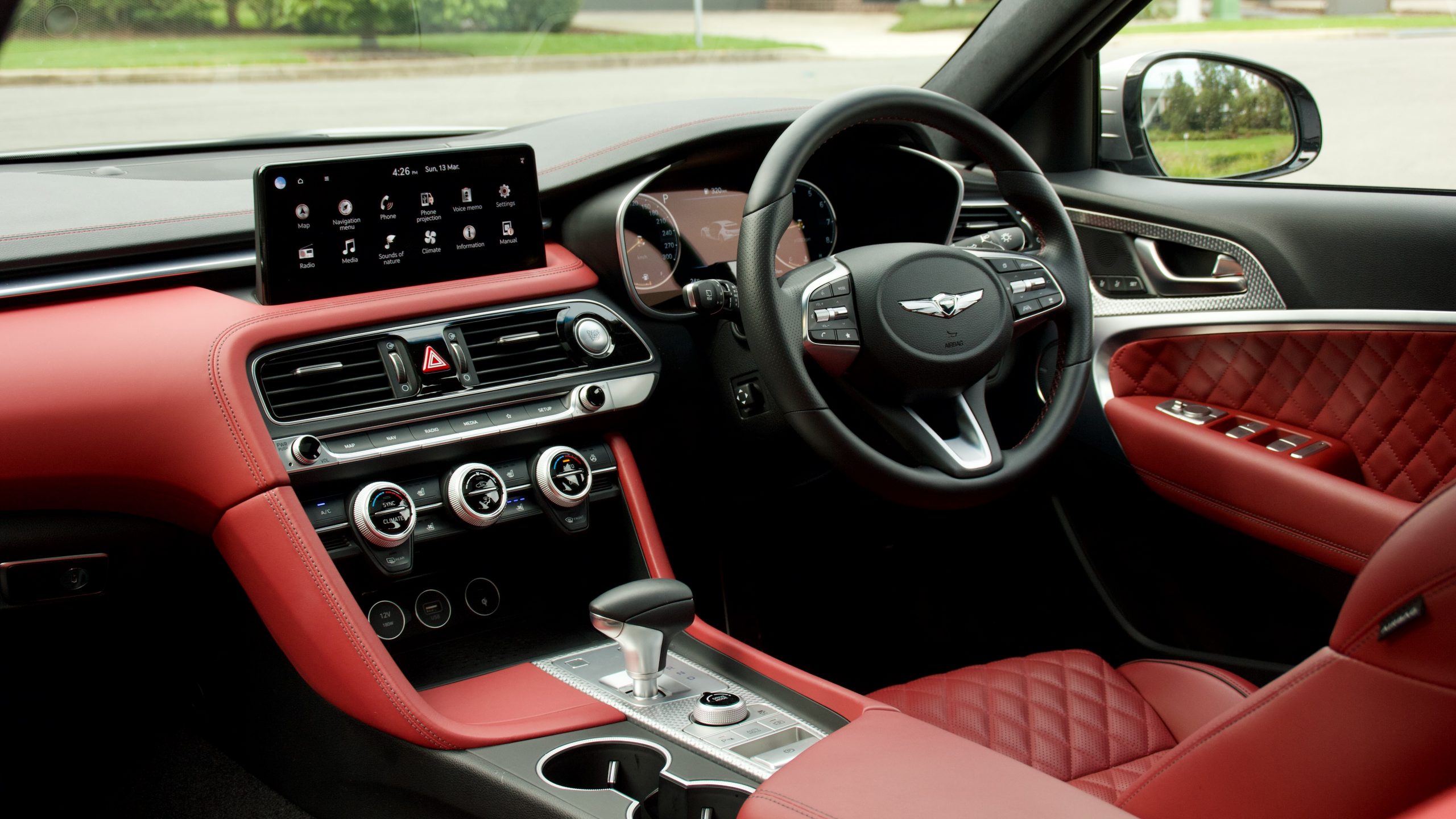
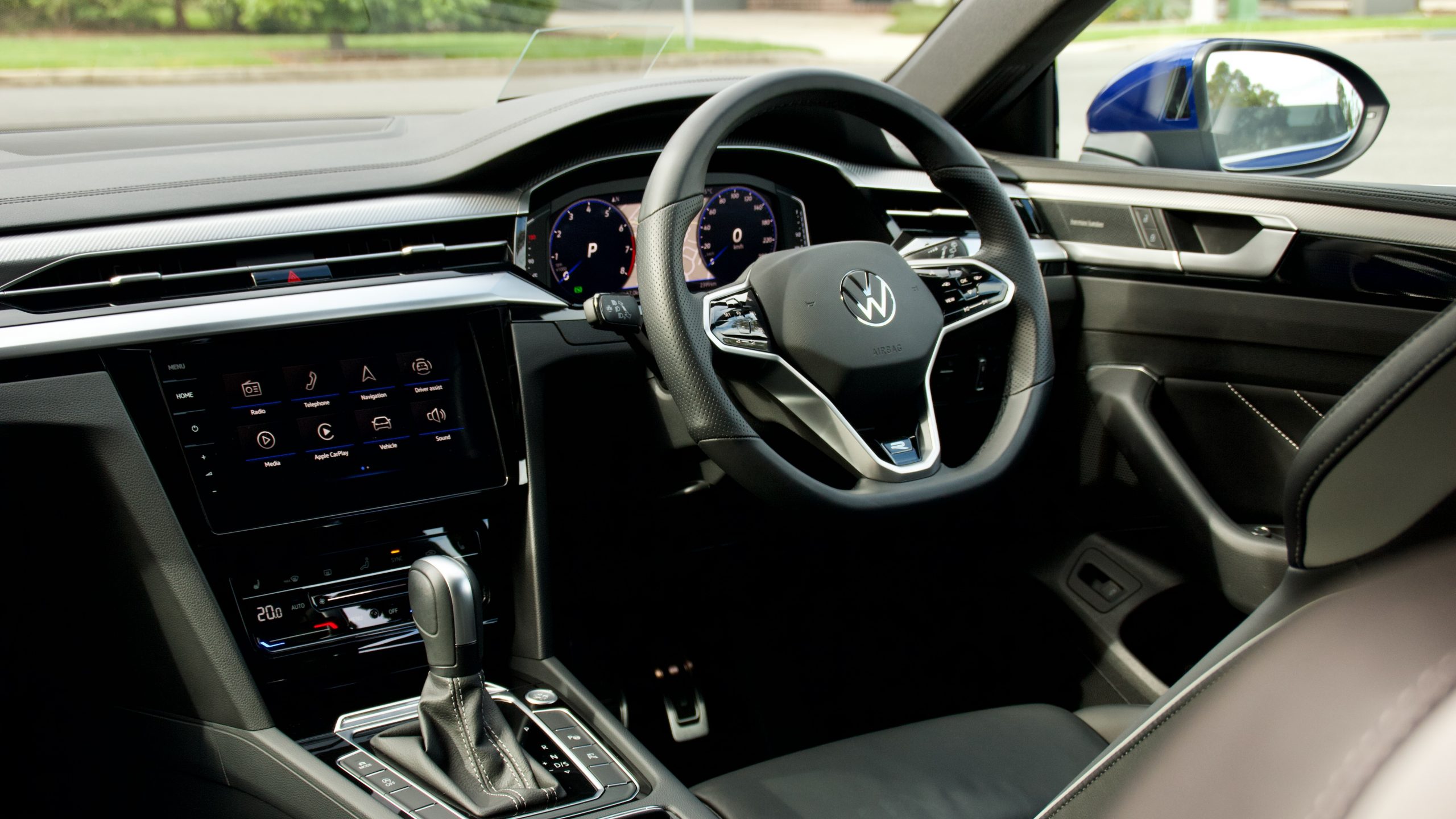
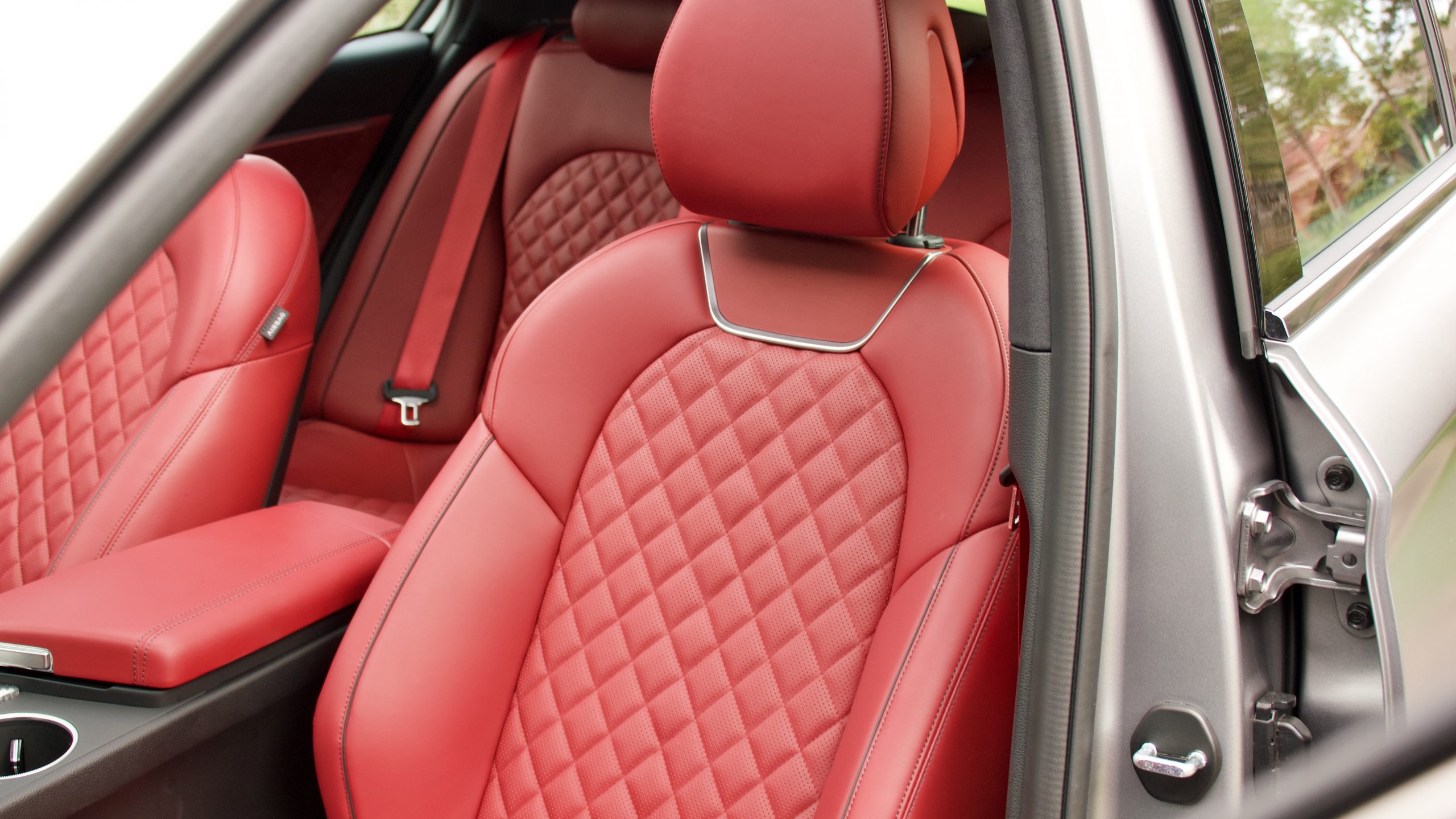
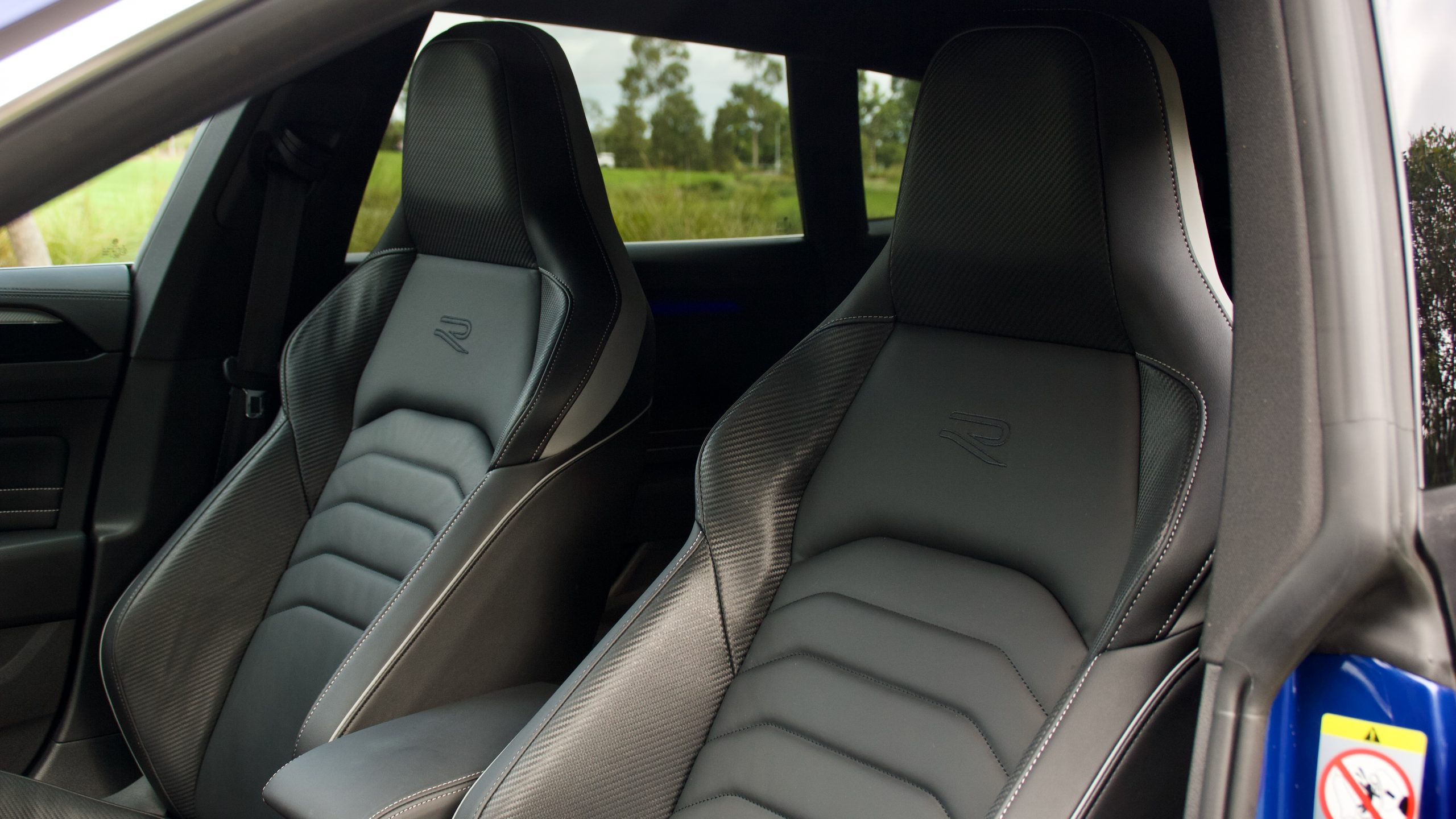
In terms of quality, the G70 just has the Arteon beaten for material quality. Lovely soft Nappa leather appears in both cars, though the G70 has more of it on the doors and more soft touch bits on the centre console and doors. The Arteon feels like a more expensive Passat, funnily enough, because that’s what it is. We think a lift in interior quality would make it feel more like the $80k they ask for it.
Both cars use large touchscreens, with the G70’s 10.25-inch screen eclipsing the Arteon’s 9.2-inch unit in both usability and features. While the Volkswagen has wireless smartphone mirroring, it does not have wireless phone charging (which the G70 does have), and nor does it even have AM radio reception. The G70 has wired smartphone mirroring and a wireless charger, and both have digital radio and satellite navigation – the G70 has live traffic as well. Both also have thumping premium sound systems – the Arteon’s is a Harman Kardon unit, whereas the G70 has a 15-speaker Lexicon system.
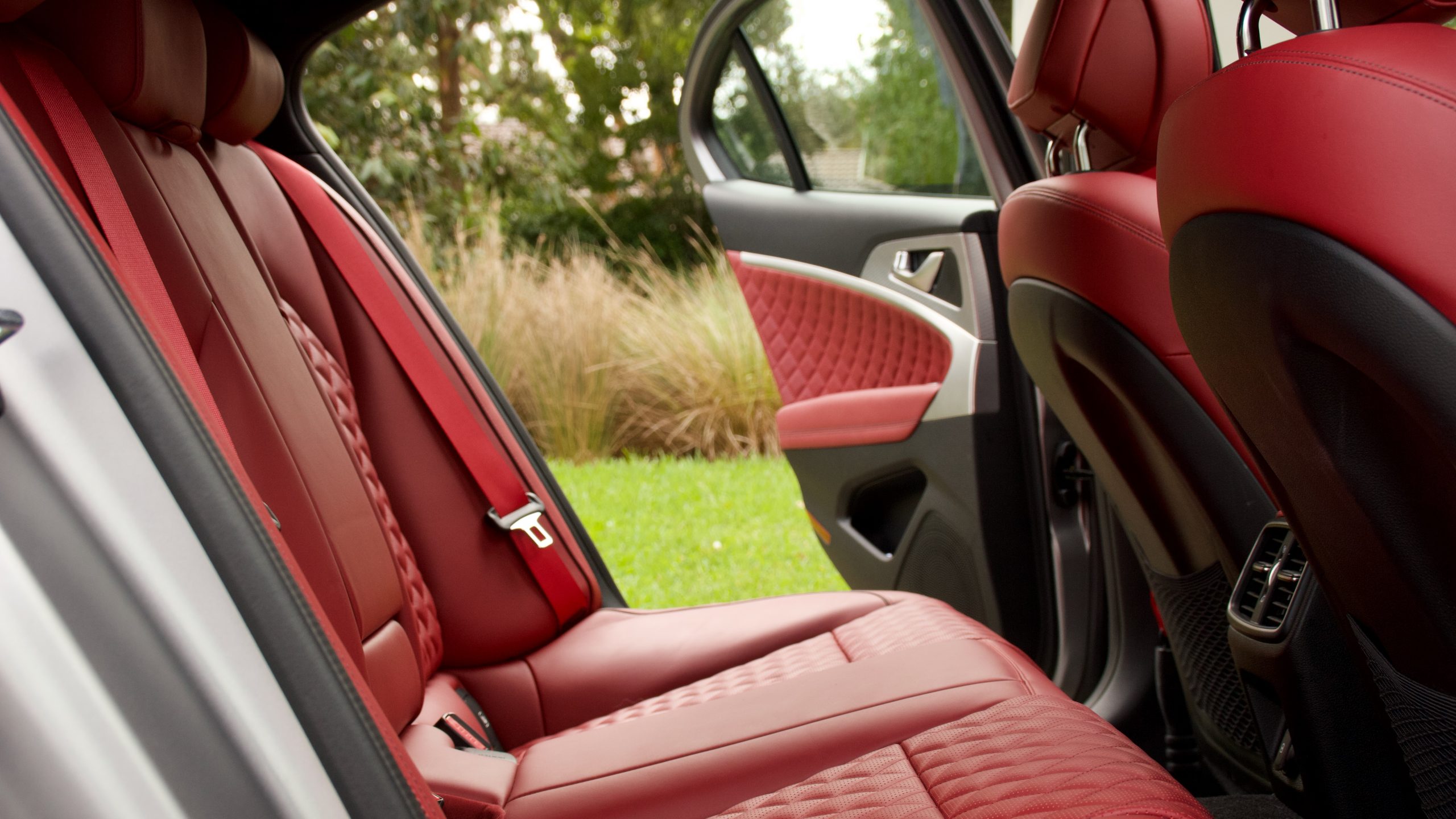
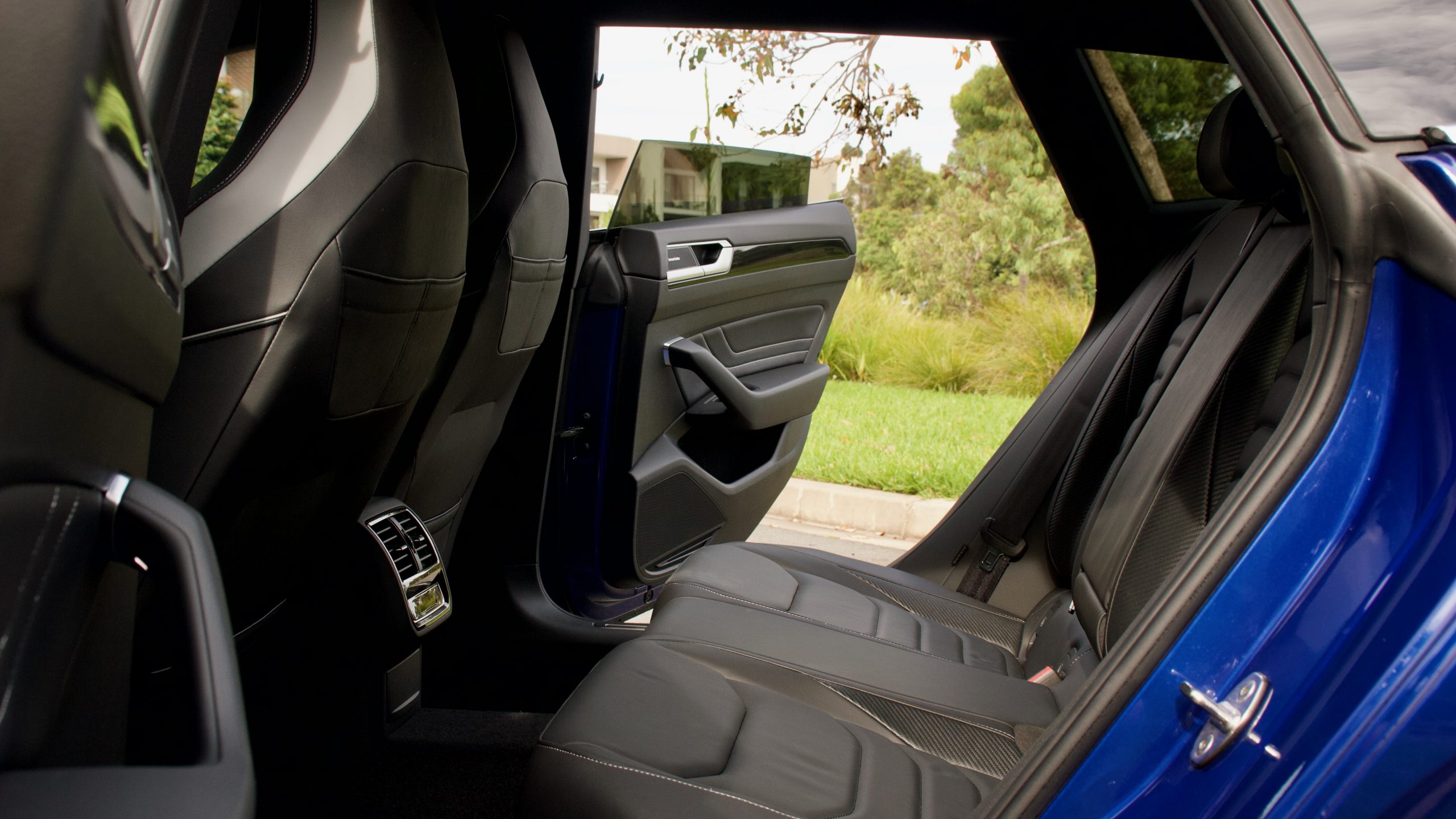
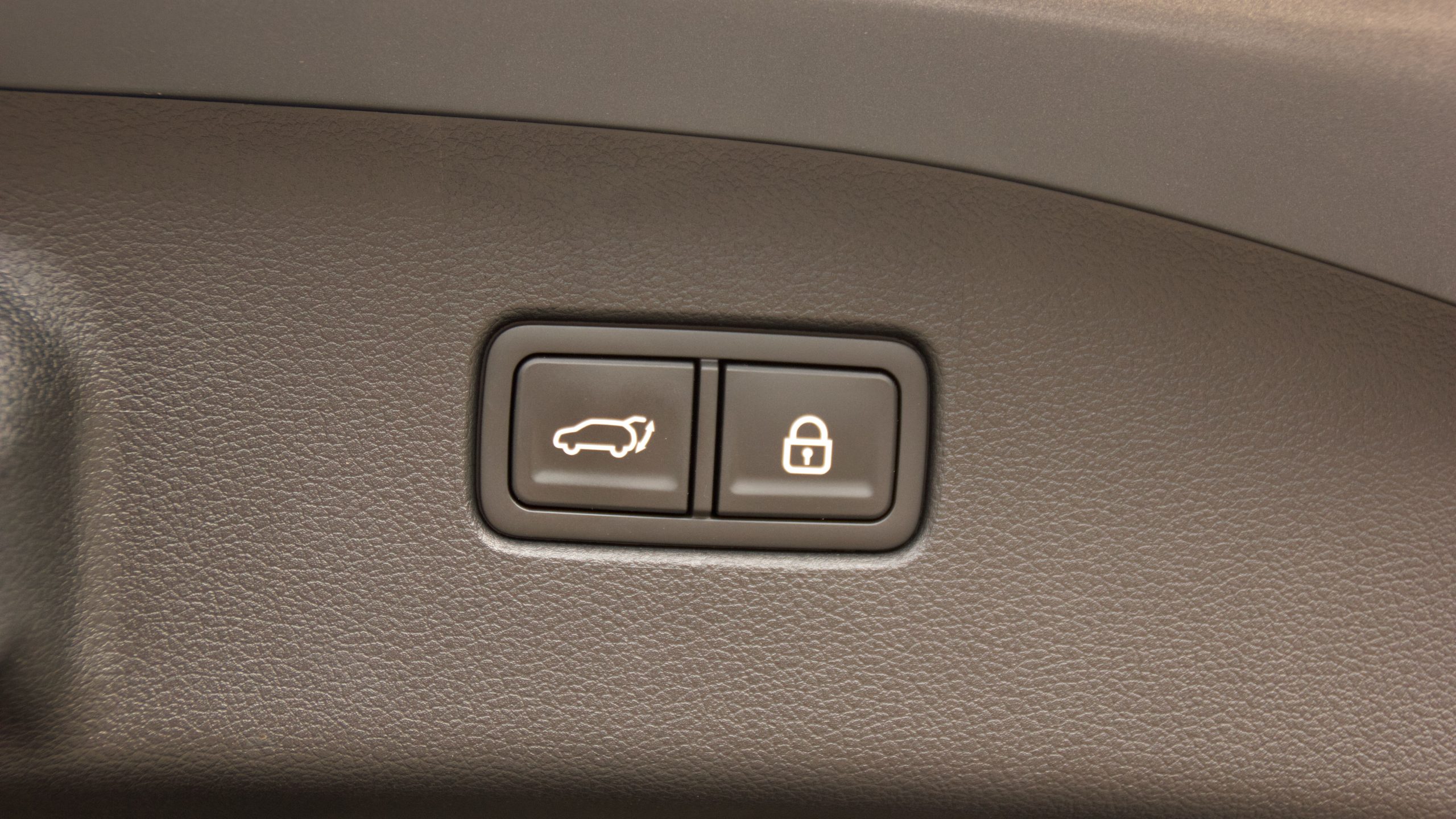
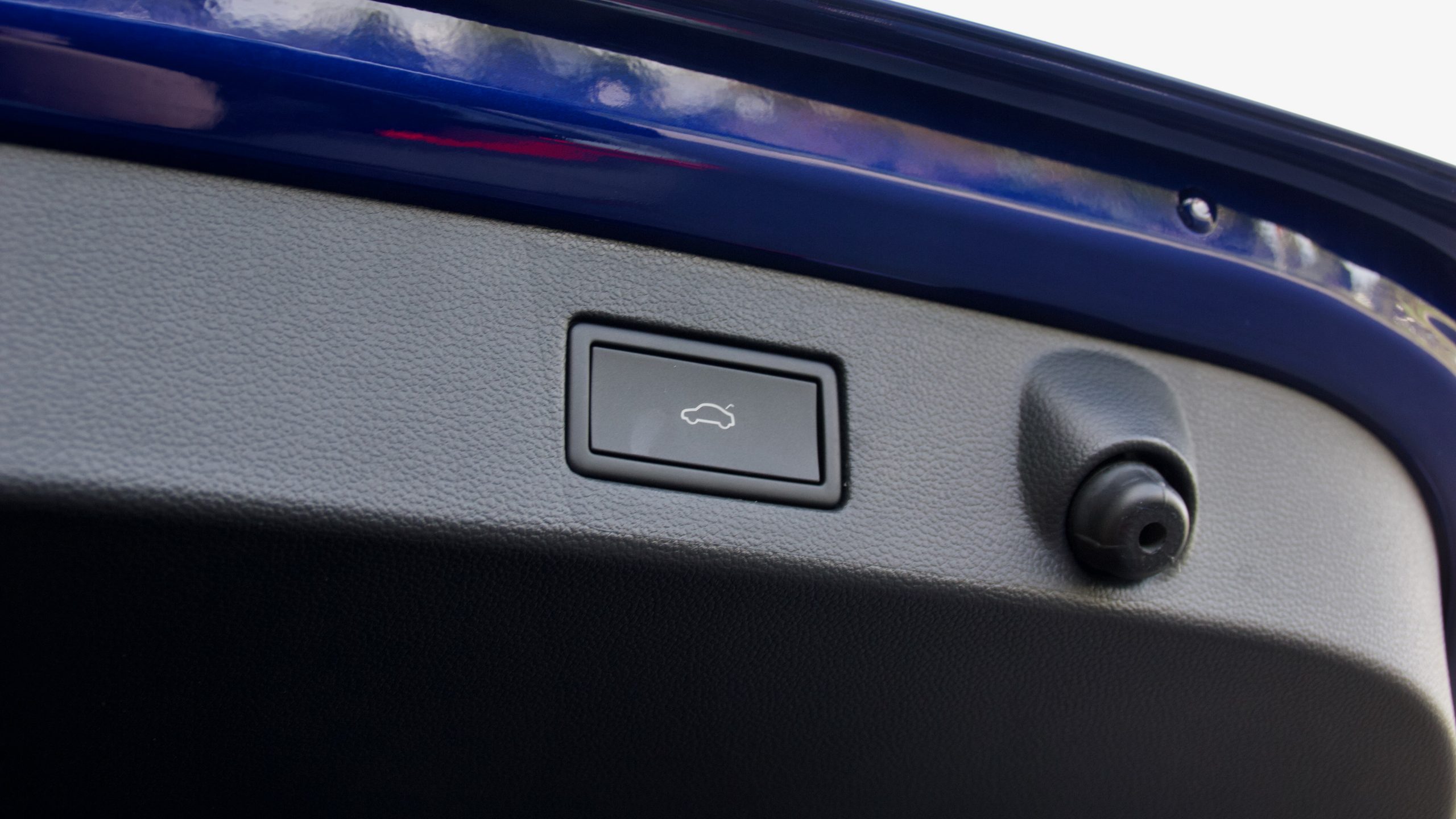
Both the Arteon and G70 have plenty of places to store your items – big flock-lined door bins, big cupholders, gloveboxes, centre armrest storage and trays underneath the dashboard for phones and other trinkets. The G70 has a wireless charger and a larger tray, edging it ahead of the Arteon.
While the front seat of the G70 Shooting Brake is the nicer place to spend time of the two, the rear seat and boot are what seals the win for the Arteon Shooting Brake in this section. Put simply, thanks to the Arteon’s extra length (4,866mm versus 4,685mm) awards it a far roomier rear seat space with a lot more legroom than the somewhat tight G70. The Arteon’s extra 47mm of height also gives it more headroom than the G70, though not quite to the same degree. The G70’s back seat is well featured with air vents, charging ports, heated seats, an arm rest with cup holders and map pockets, but the Volkswagen adds window shades and a third climate zone to those features.
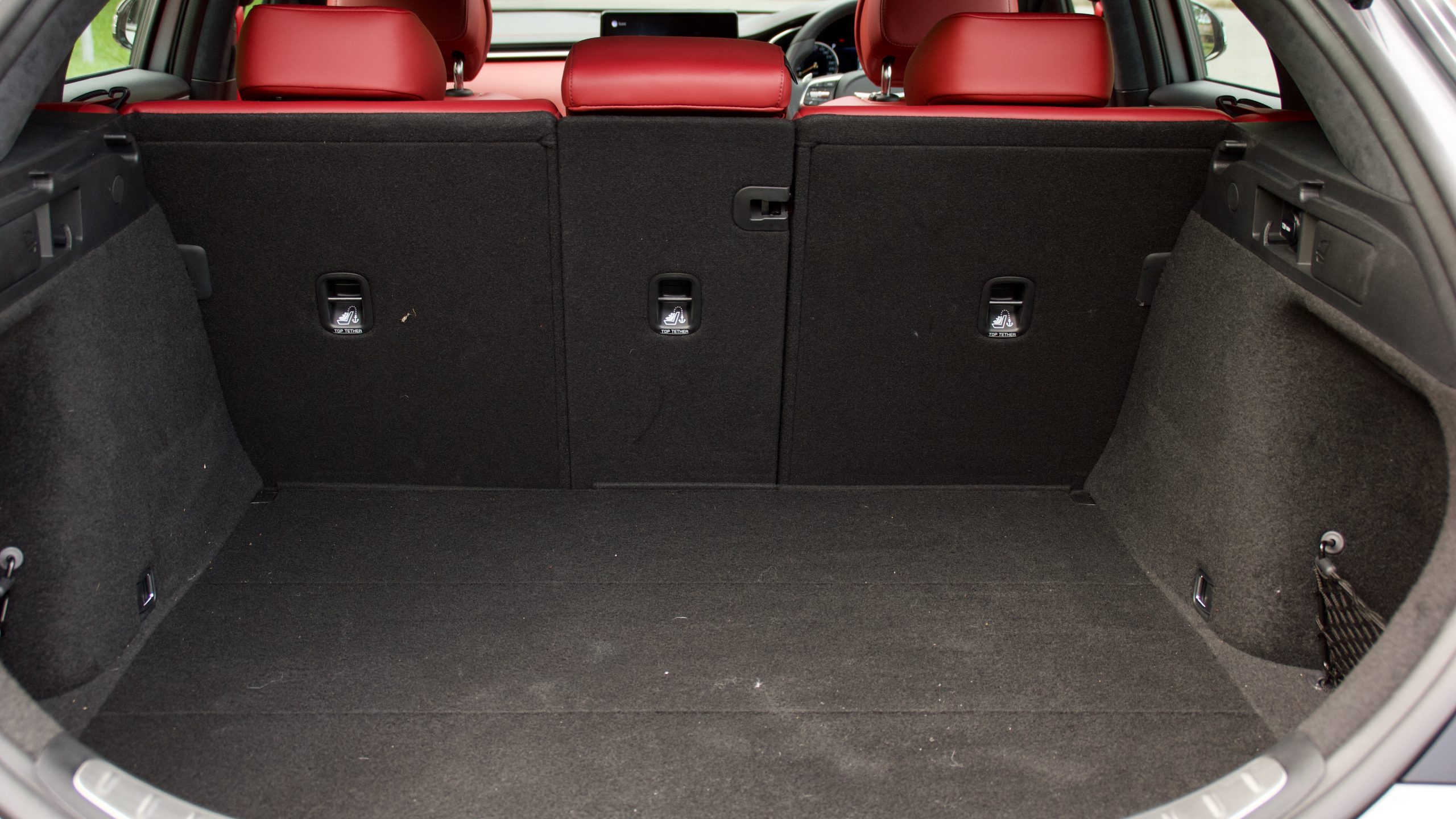
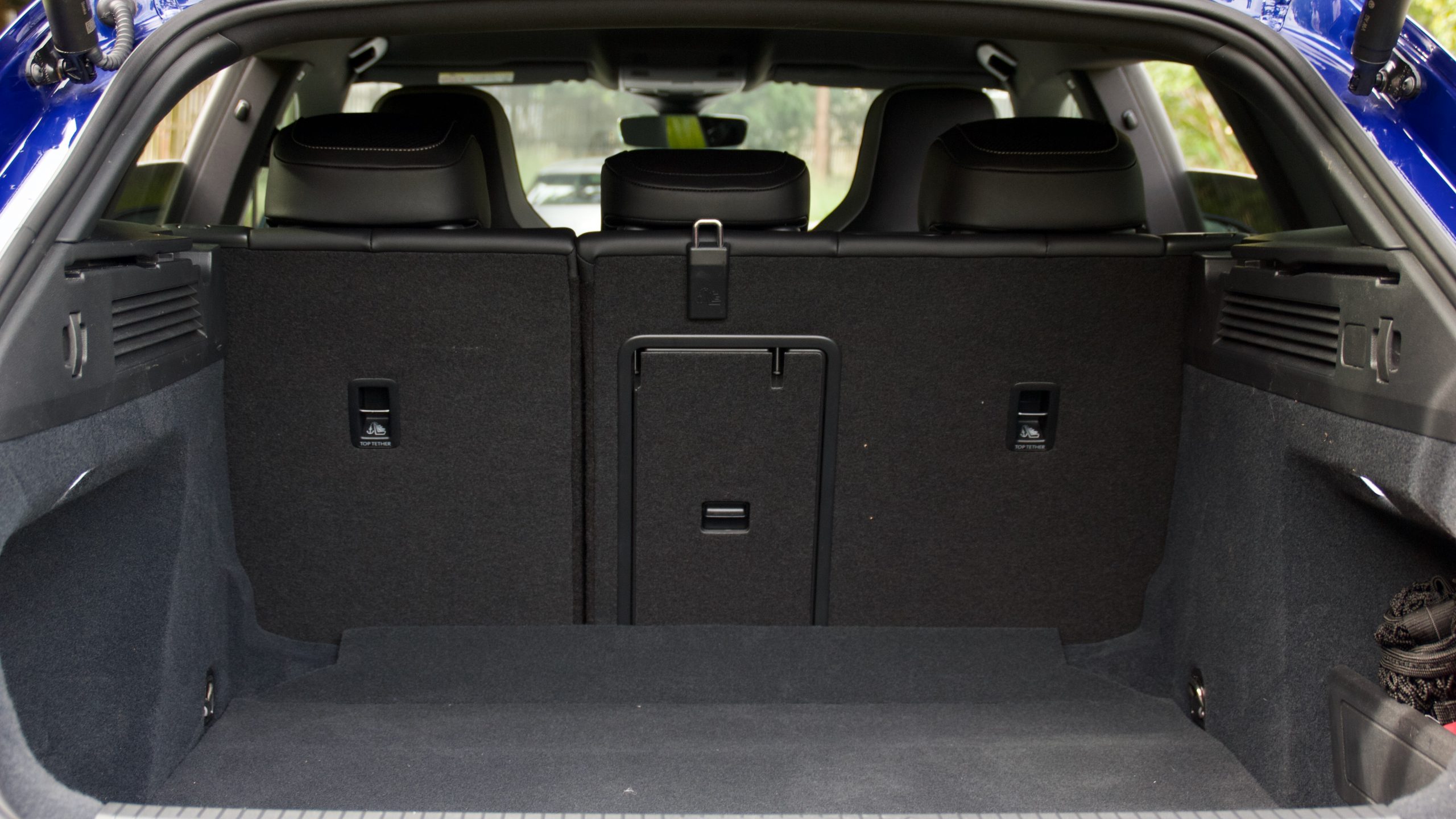
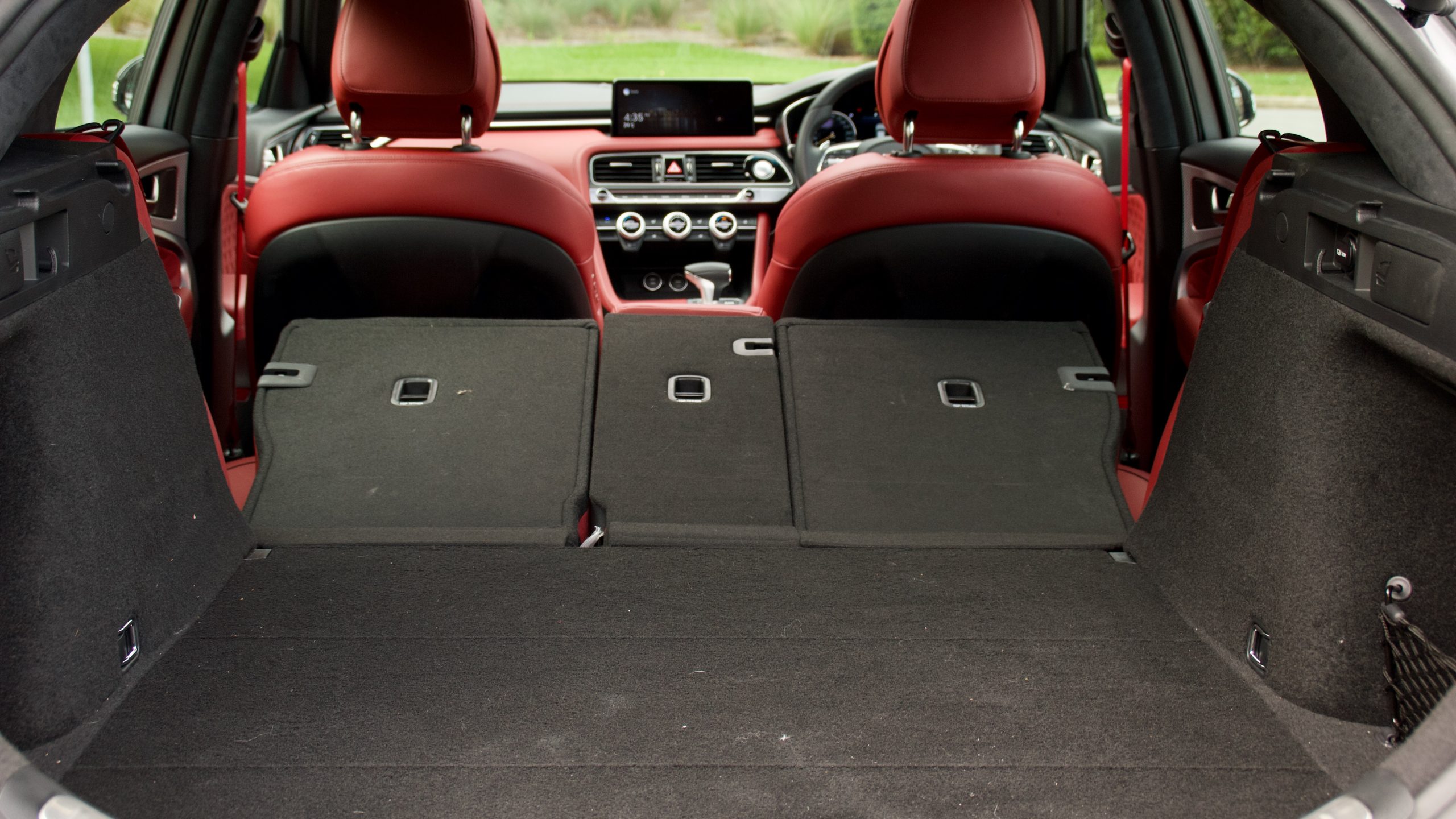
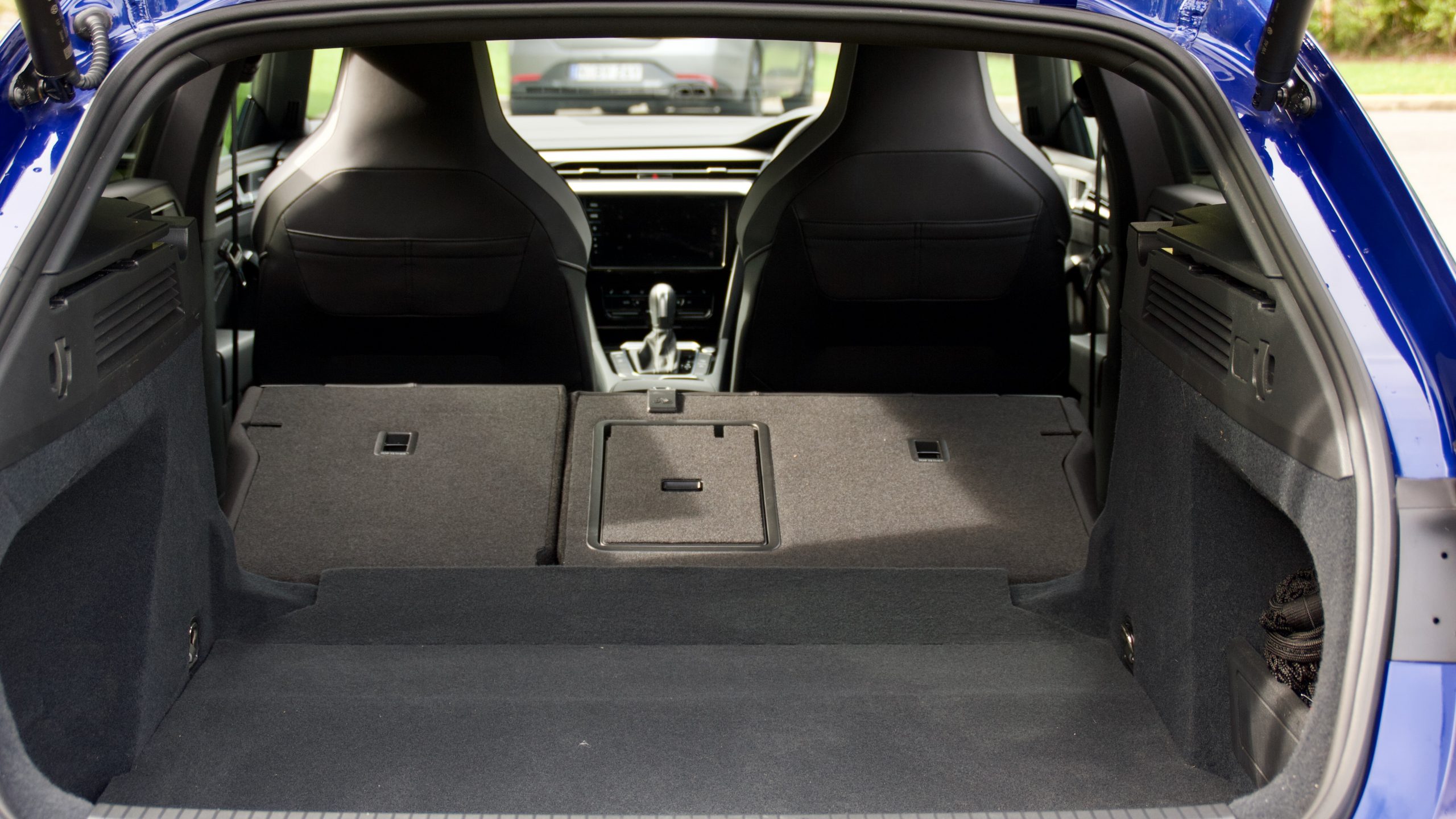
The boot space of both cars is like the back seat: the Arteon is much bigger, by 100-litres (565L v 465L in the G70) with the seats upright. Folding the seats unlocks 1,535L of space in the Genesis, and a huge 1,632L in the Arteon. The Genesis’ boot is better finished with a nicer carpet, and both have cargo hooks and separate storage on either side of the boot floor, while the Genesis’ sets can be folded using the tabs on each side of the boot. Not unusually for a car from the Hyundai Kia group, the G70 has a full size alloy spare wheel – but very surprisingly, so does the Arteon.
Interior & Practicality winner: Volkswagen Arteon 206TSI Shooting Brake
Service & Warranty:
Both the Arteon and G70 feature five-year/unlimited km warranties, though the Genesis’ is slightly superior as it includes roadside assistance for the duration of the warranty, whereas Volkswagen only gives you 12 months from purchase, which is then only topped up a further 12 months with each dealer-performed service (up to five years in total).
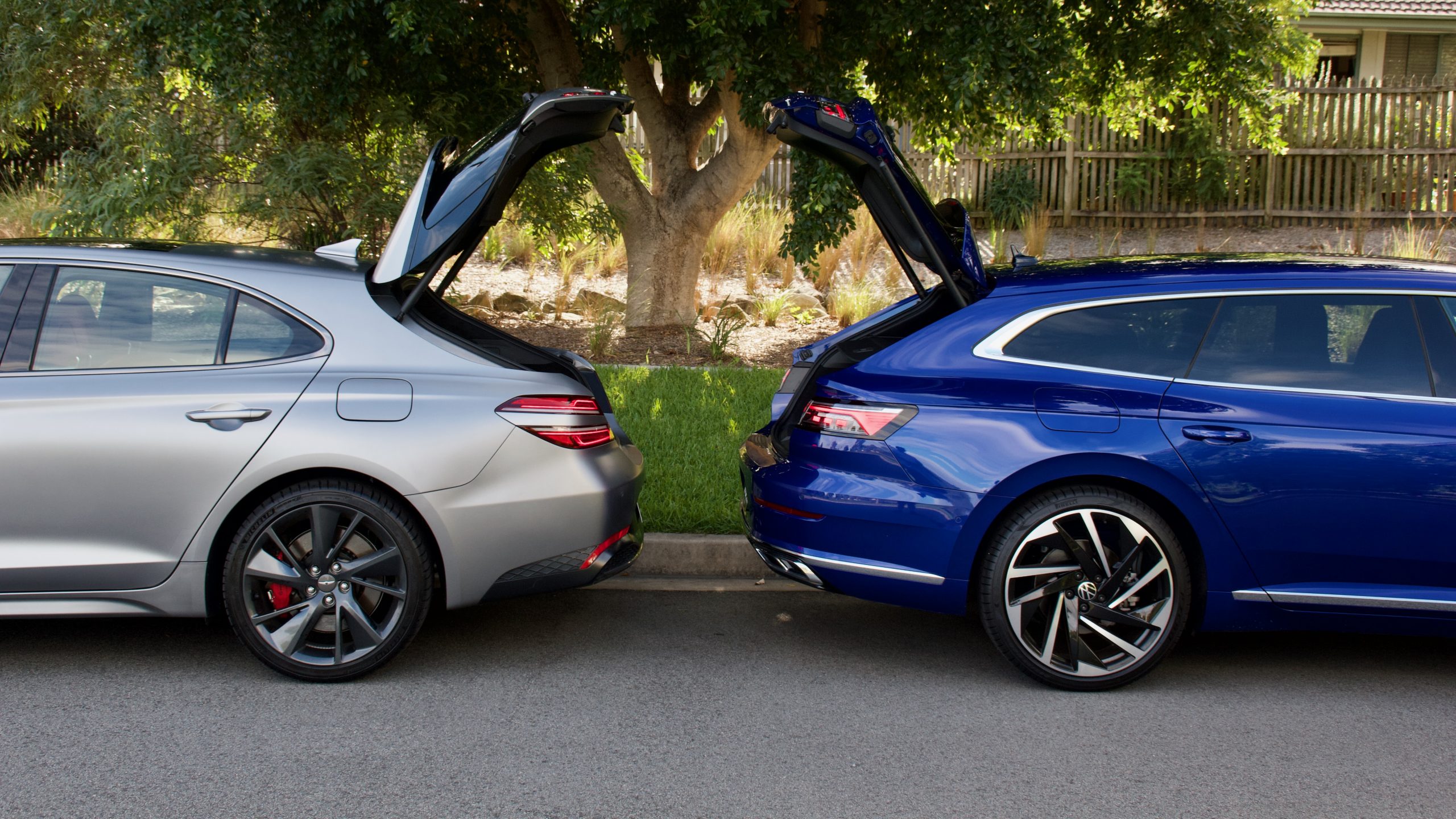
Five years of servicing the G70 is included in the purchase price of the car. Doing the same with the Arteon costs a ludicrous $3,565 (including a $1,280 four-year service alone), which equals an average of $713 per service. Buyers can choose a slightly less expensive five-year service plan at the time of purchase for $2,700 ($540 per service), but even with the Arteon’s longer 15,000km service intervals (versus the G70’s 10,000km intervals), the G70 is far more cost effective to service.
Service & Warranty winner: Genesis G70 Shooting Brake
Which is Best: The Arteon Shooting Brake or the G70 Shooting Brake?
Both the Volkswagen Arteon and Genesis G70 Shooting Brakes are polished products capable of providing all-day comfort, fun driving dynamics, good performance, reasonable practicality, lots of standard equipment and – as their names suggest – a slinky take on the traditional wagon bodystyle. Their existence alone is a big win for enthusiasts and families alike, especially in the days of SUV sales dominance. But one of these cars is a better product than the other, and that’s the Volkswagen Arteon Shooting Brake.
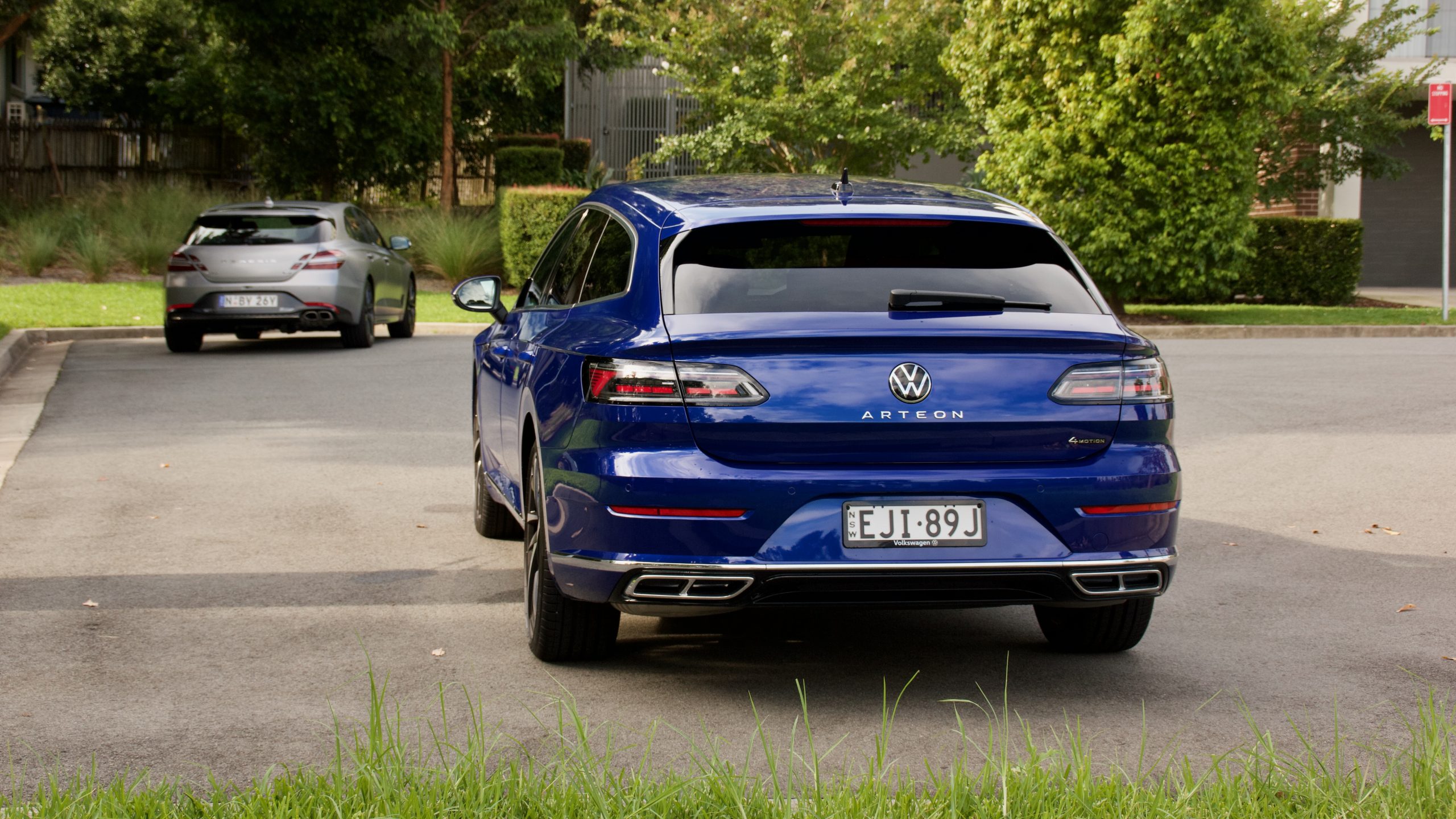
There’s nothing particularly wrong with the G70 Shooting Brake, but we just wish it were slightly more practical – in this sense, it is truer to the shooting brake form than the Arteon, which is really just a sexier wagon – and had a more exciting engine. The Arteon is where those two needs are found, and it’s also cheaper to buy, more fuel efficient and has a much larger boot. Both are far superior to an SUV, but if you’re after a stylish wagon, the Arteon Shooting Brake is what comes out on top in this comparison.
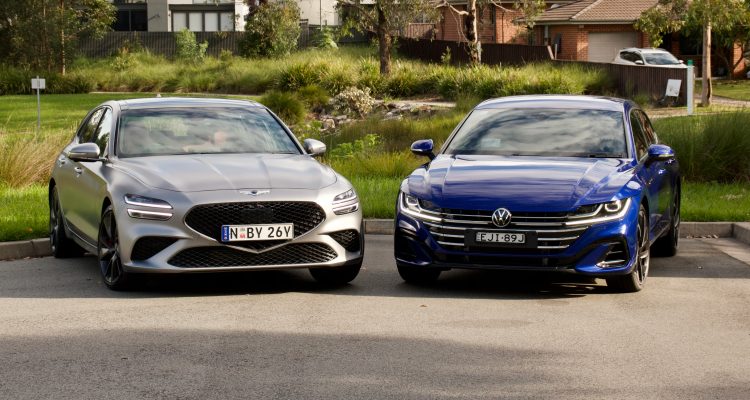
Leave a Reply